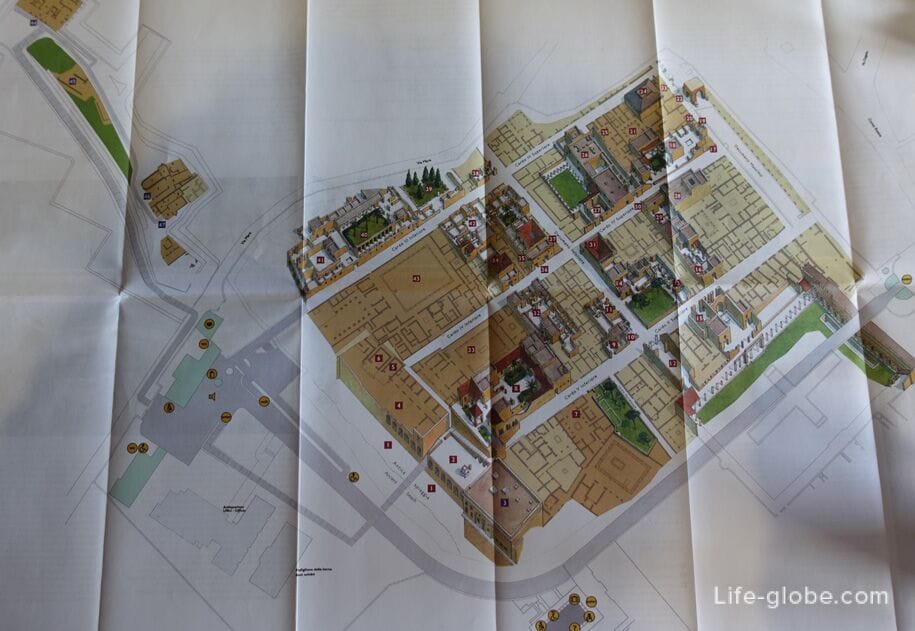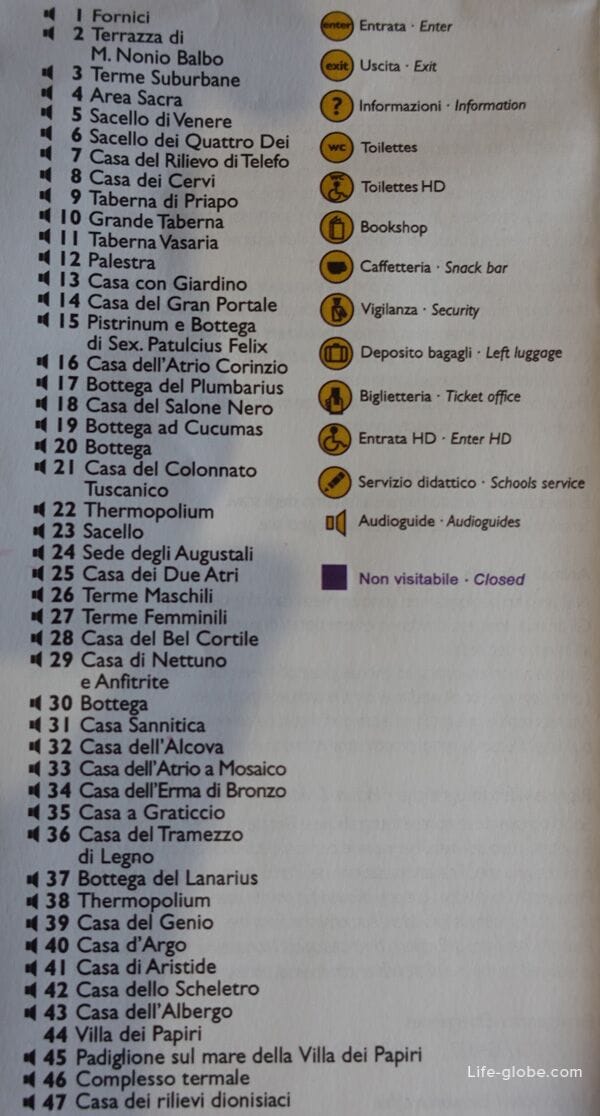
Herculaneum (Ercolano) is an ancient Roman city, known, like its sister city of Pompeii, in that in 79 AD it was destroyed and buried under a layer of pyroclastic flows during the eruption of Vesuvius.
In 79 sudden roar interrupted the daily way of life at the foot of Vesuvius. A column of volcanic ash rose to a height of 14 kilometers, forming a cloud of large dimensions. Driven by the wind, she began to settle "rain" of lapilli and pumice at Pompeii and nearby settlements. This marked the beginning of a disaster.
After a few hours, the volcano produced an impressive number of pyroclastic material, which forever changed the landscape of Vesuvius, and with it the settlements at the foot of the volcano. Herculaneum was first annealed "burning clouds" temperature reaches 400 degrees, moving at a speed of about 80 miles per hour, and then buried the city under a 20-metre blanket of volcanic rock.
Currently Herculaneum is an archaeological site in the open air archaeological Park of Herculaneum (Ercolano archaeological Park - Parco Archeologico di Ercolano / the archaeological area of Herculaneum - Archaelogical area of Herculaneum), located in Campania, Vesuvius, in Ercolano, 10 km from the historic centre of Naples.
Herculaneum is one of the few ancient cities, preserved more or less intact, without significant modifications.
Unlike Pompeii, heavy blanket of lava that covered Herculaneum, char structure, and not destroy them, thus saving wood and other organic materials, such as roof, bed, doors and food. Despite the fact that most residents managed to leave the city before the eruption of lava, in 1997, was discovered well-preserved skeletons of 300 people dead near the sea, in an attempt to escape from disaster.

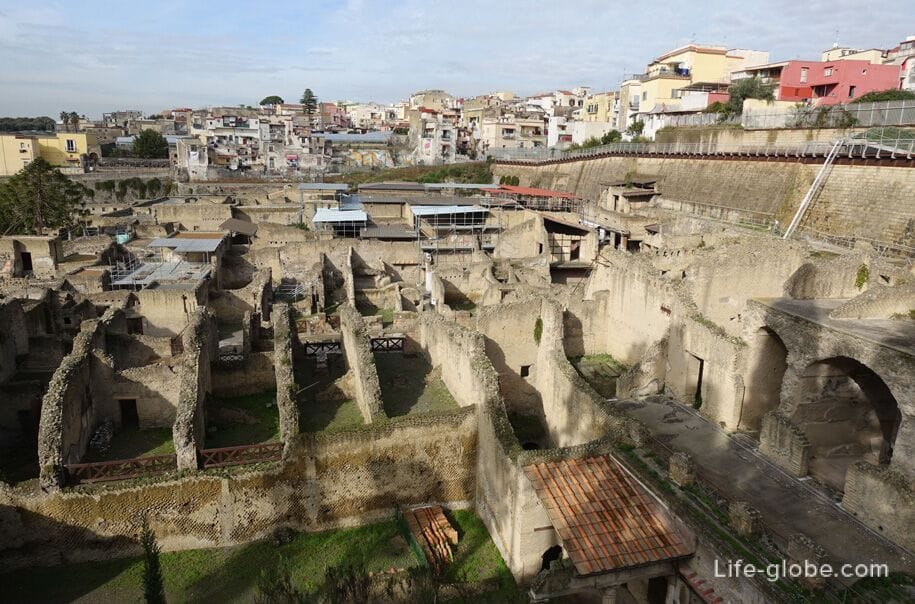
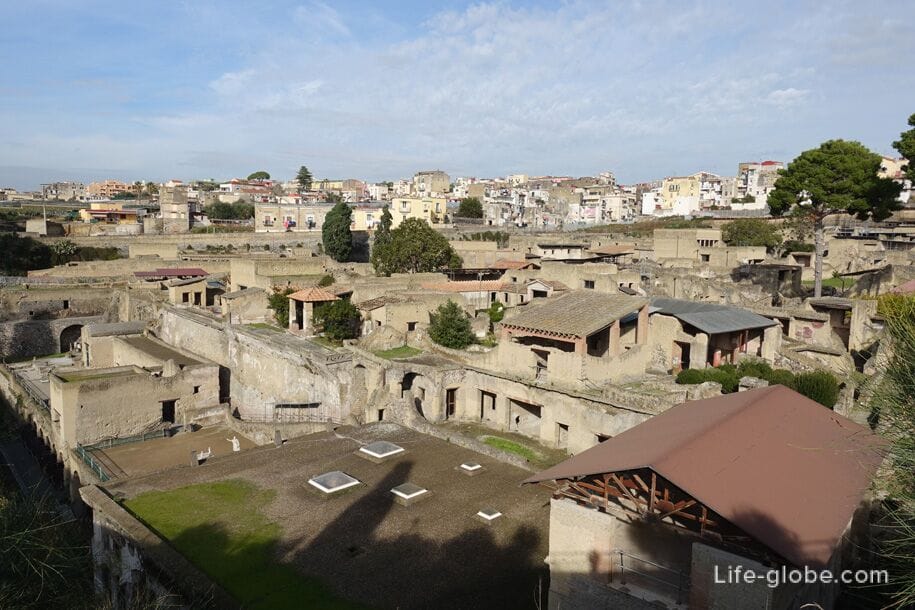
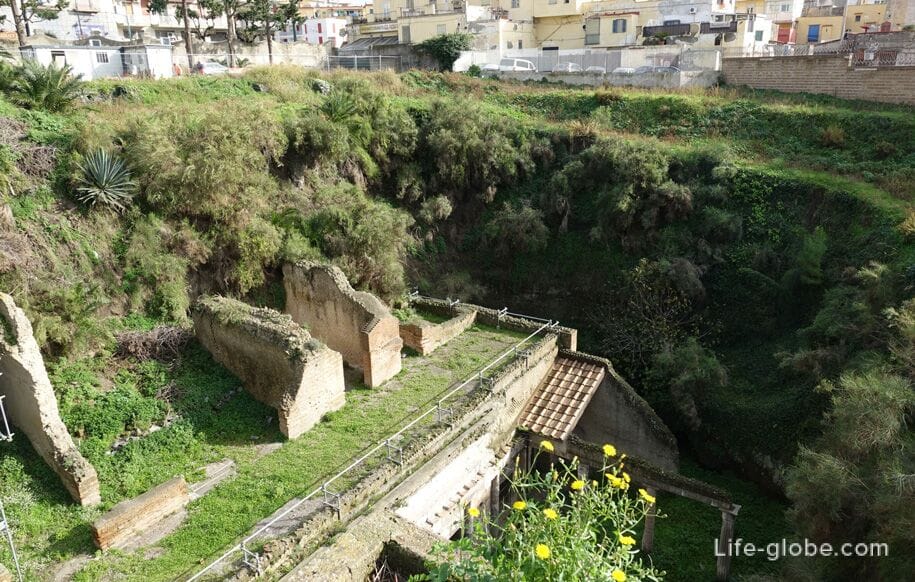
The first systematic research of the ancient Herculaneum began in 1738 through a network of wells and tunnels. The hardness of the volcanic rocks has led to the fact that the excavations were suspended. Only in 1927 the excavations of Herculaneum was resumed, which was released, restored and open to the public most of the territory, which today represents the archaeological Park. Following significant finds in the excavation were made in the 80s and 90-ies of the twentieth century.
Today, the Park Herculaneum, along with Pompeii, a UNESCO world heritage site. However, unlike Pompeii, Herculaneum is a pretty small area, but not less important, with its urban appearance, an old civilization and, more valuable, with its "human face".

In the archaeological Park of Herculaneum is located a few streets on both sides of which the remains of houses and villas, shops and public baths. Also, the remains of the market square fountains, the palestra and boat sheds with the skeletons of the victims.
Photos of the streets of Herculaneum Park
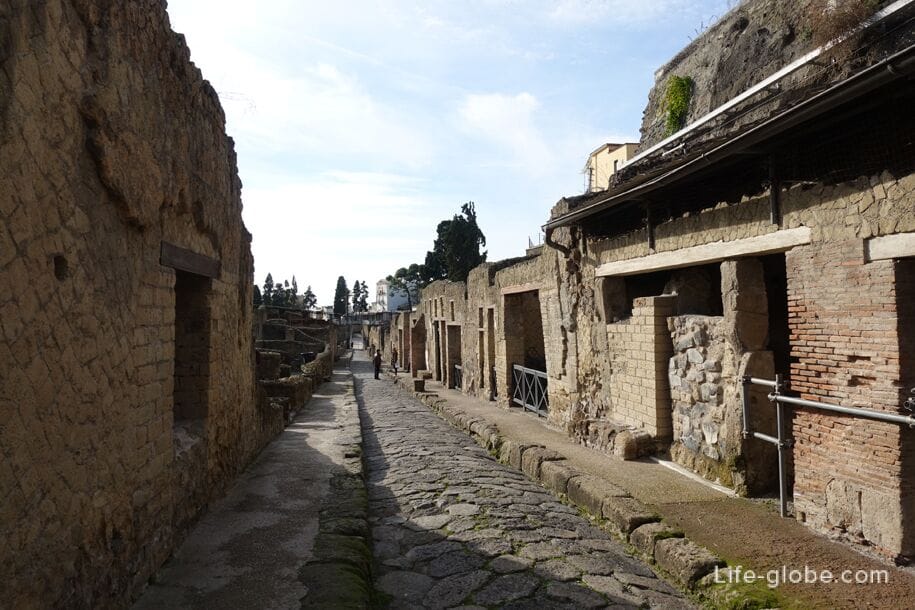
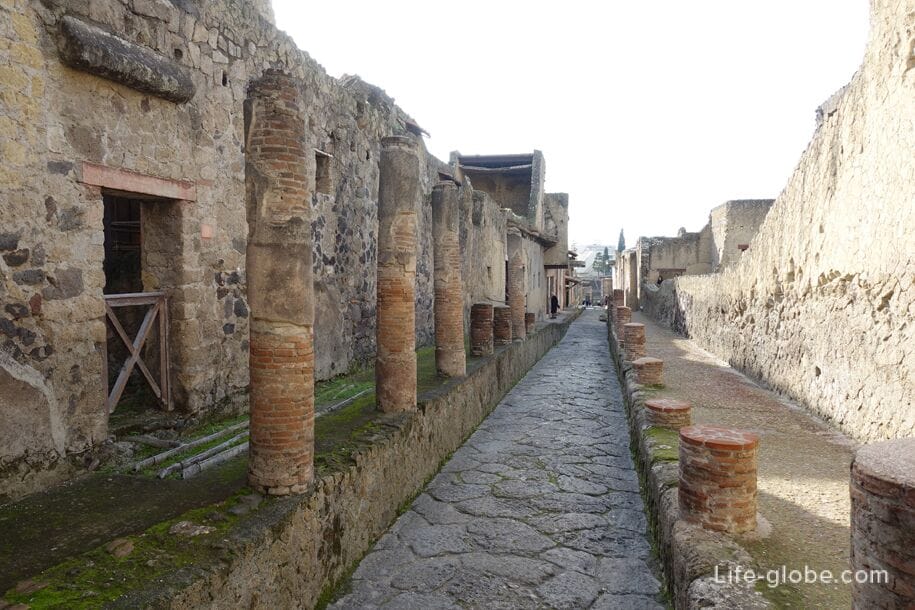
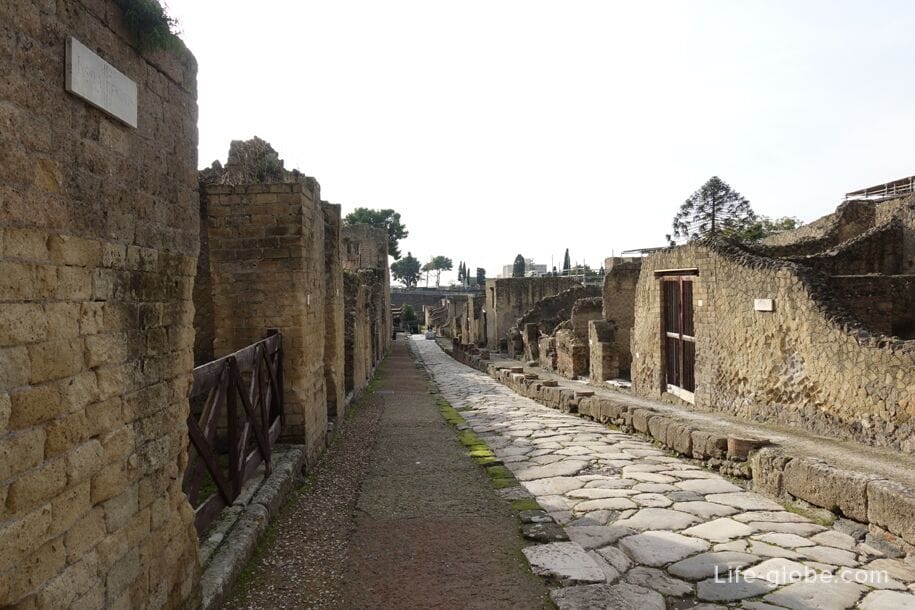

The basis of the archaeological areas of Herculaneum are the remains of a typical Roman houses, the first floor of which was often divided into two separate sectors. The first sector is located around the atrium, directly connected to the road (street) General use, through a narrow corridor. Main room there was a room where the owner received guests, managed their Affairs and spent much of the time.
The second sector was a so-called private part, where were concentrated the bedrooms, guest rooms and other premises intended for the personal use of owners.
An important part of the house was also the dining room, it's flaunted all the best and most meaningful, everything that wanted to brag and show their position during feasts, celebrations and other events.
Some houses had gardens with porticoes and fountains or sculptures in the center.
Contrary to popular belief, slaves lived in apartments, often small, but fully equipped and is located on the upper floors of buildings. Some lived in the house of the owners and was in complete disposal for any needs. The most educated could be teachers or nurses, while the other performed the most humble work around the house and yard.
Important was the figure of the servant, who controlled the entrance. For it was assigned a small room right near the atrium - public part of the house. Some slaves remained in their jobs even during the eruption, as evidenced by skeletons found. Often the owners have been associated with slaves fairly close relationship continued even after the release of the latter, as evidenced by tablets found in one of the houses. Other important figures were the chef - they cooked meals for family and guests.
Now the remains of each building have its name
Aristidou house (casa di aristide). The entrance opens directly into the atrium, but the remains of the house is not particularly well preserved due to damage caused by previous excavations. The lower floor was probably used for storage.
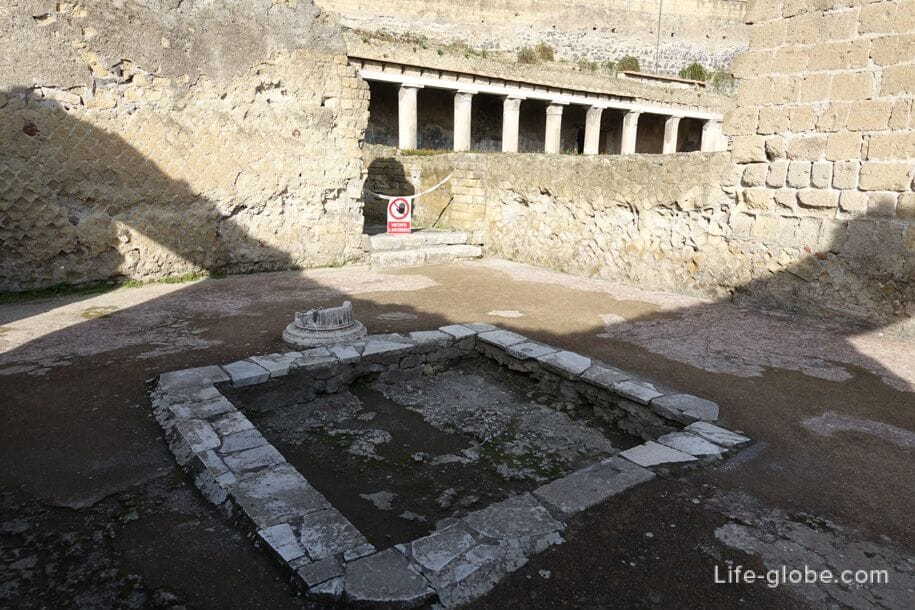
The house of Argus (casa d Argo), which received its name from a fresco of Argus and IO which once adorned the structure. The mural is now lost, but its name lives on. This building must have been one of the best villas in Herculaneum. As a result of excavations was discovered a balcony on the second floor, and wood shelving and cabinets, but over time these elements have been lost.
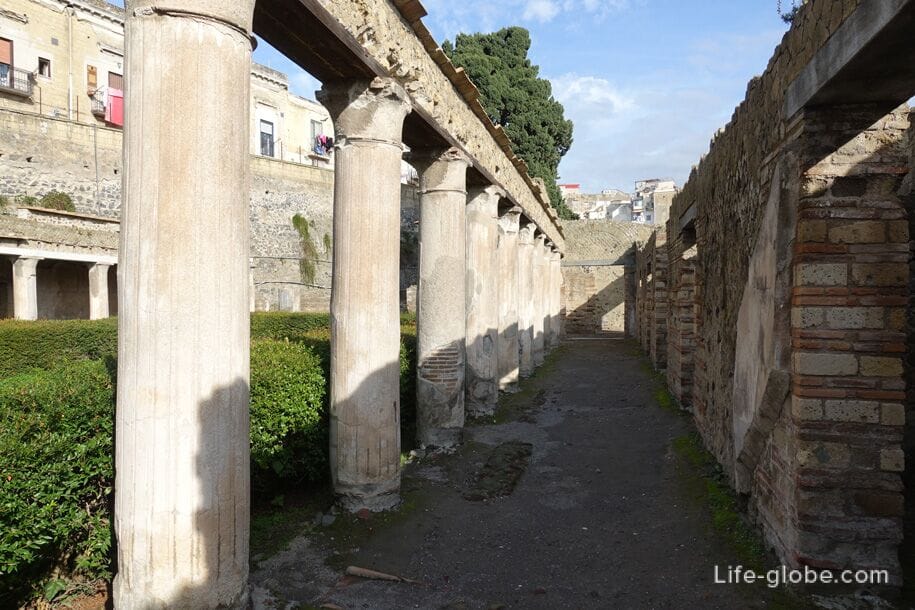
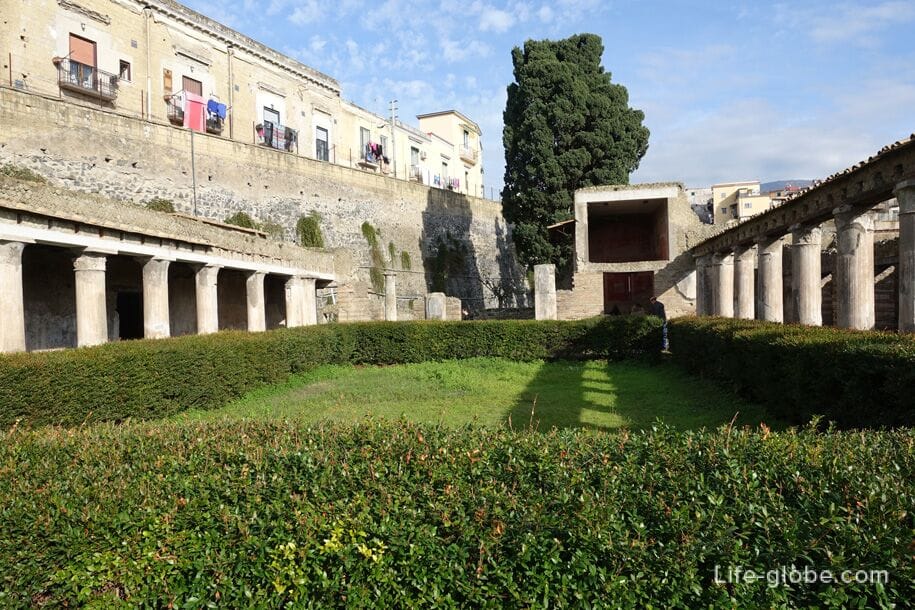


House Albergo (Albergo casa Dell) is a good example of large houses of Herculaneum.

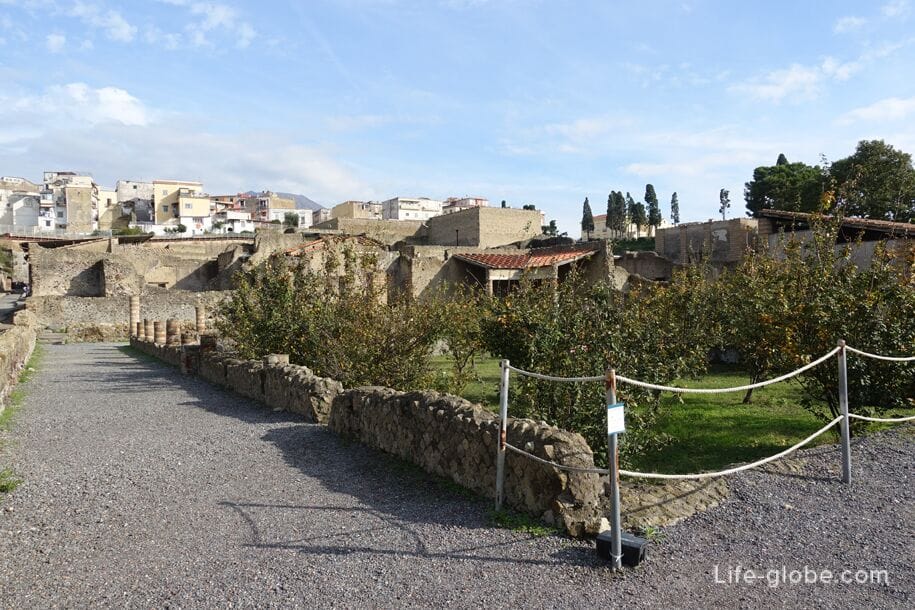
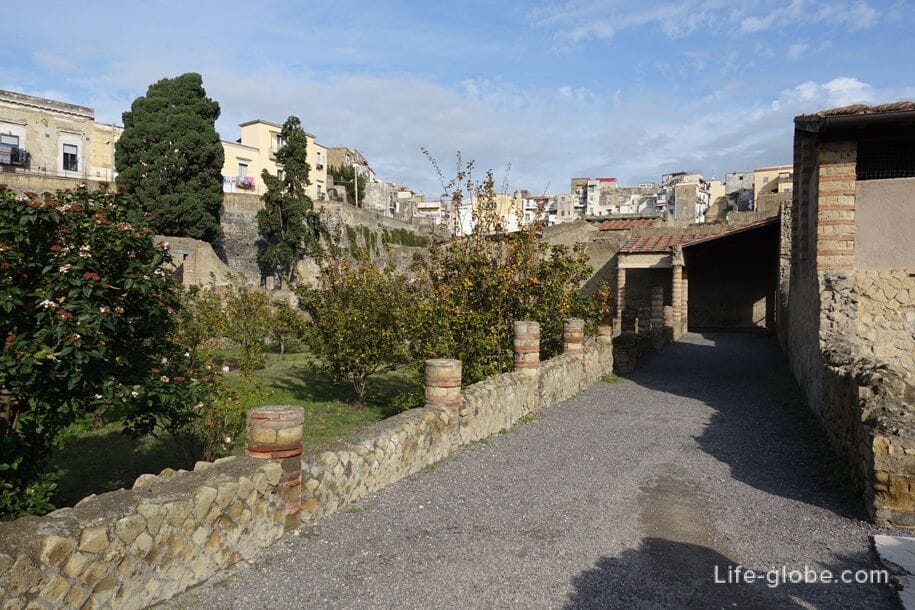
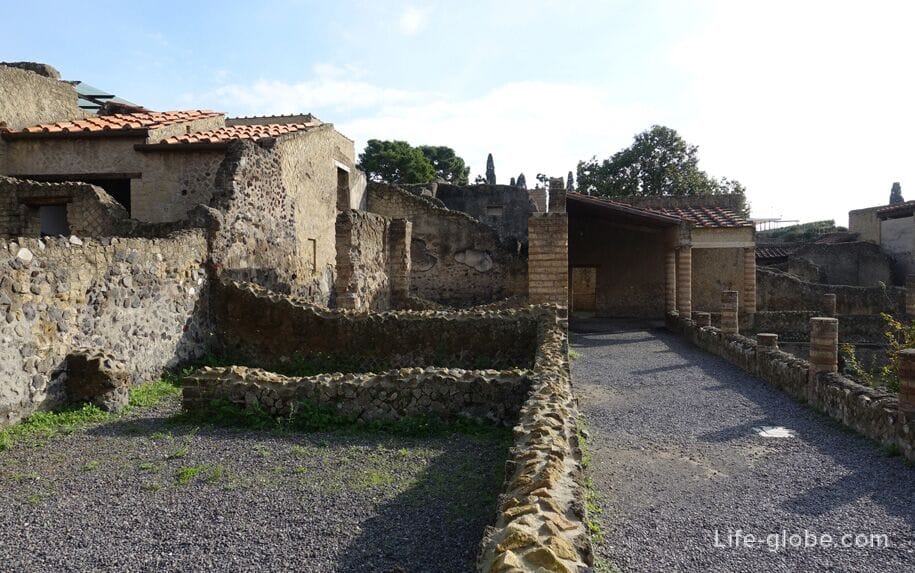
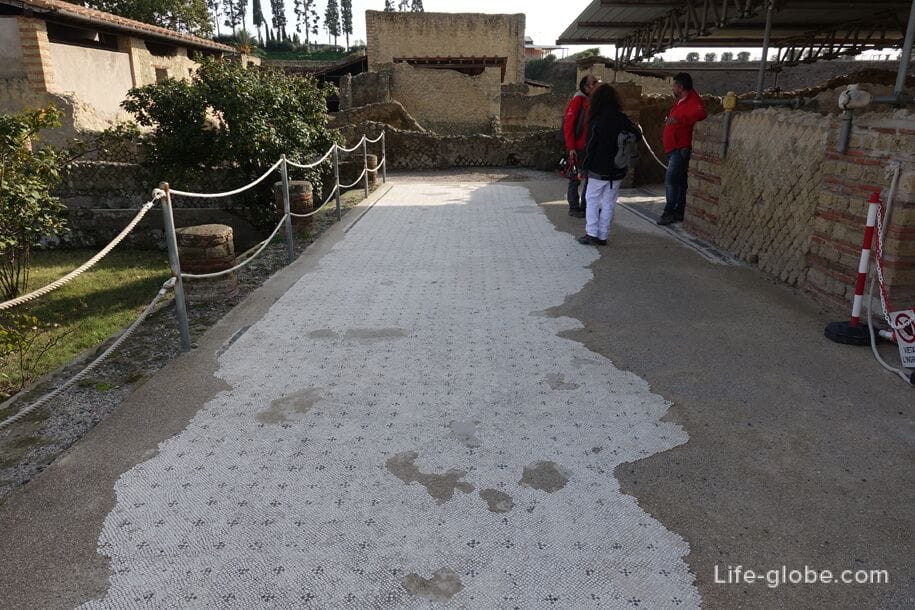
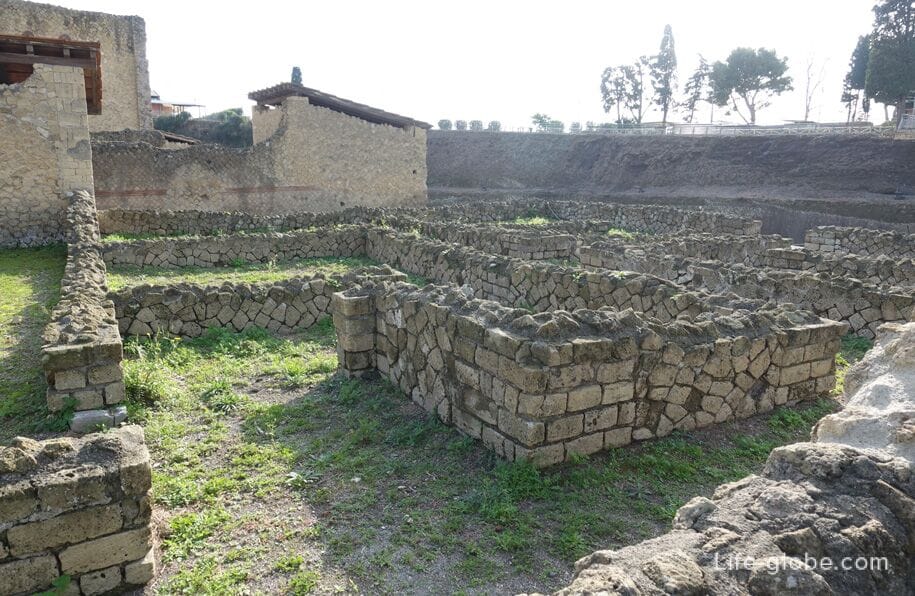
House of Genius (casa del genio). The building is partially excavated, but, apparently, it was a spacious structure. The house got its name from the statue of Cupid, which was part of the candlestick.
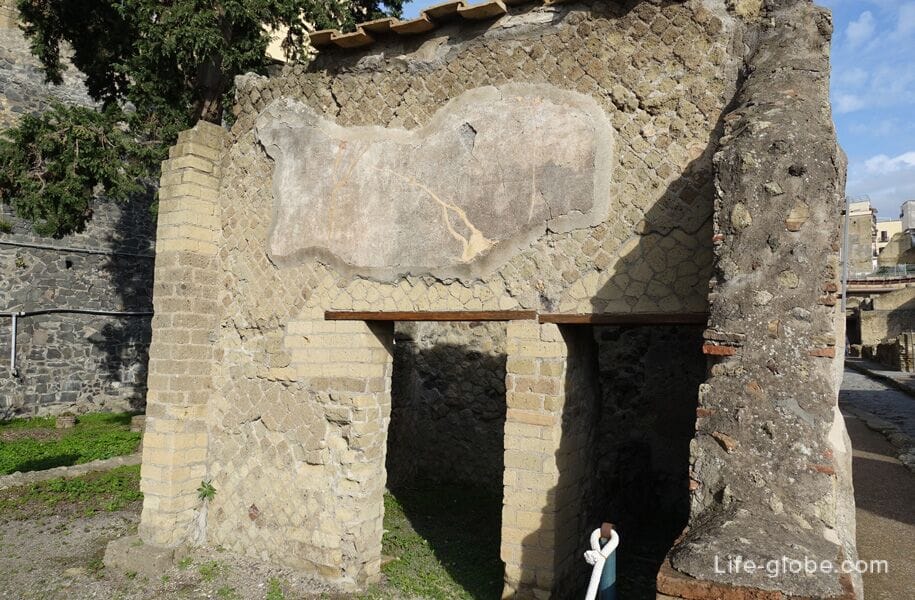
Skeletal house (casa delo scheletro). During excavations on the upper floor of the house was found the skeleton. The current appearance of the building, which consists of 3 pre-existing houses are oblong, the Central one of which had a covered atrium. In the house there are frescoes and mosaics.
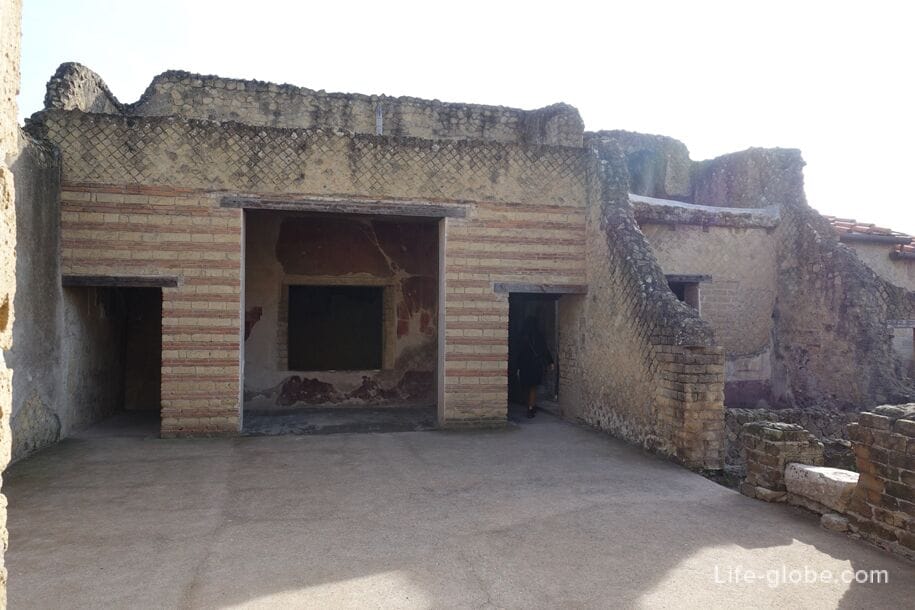

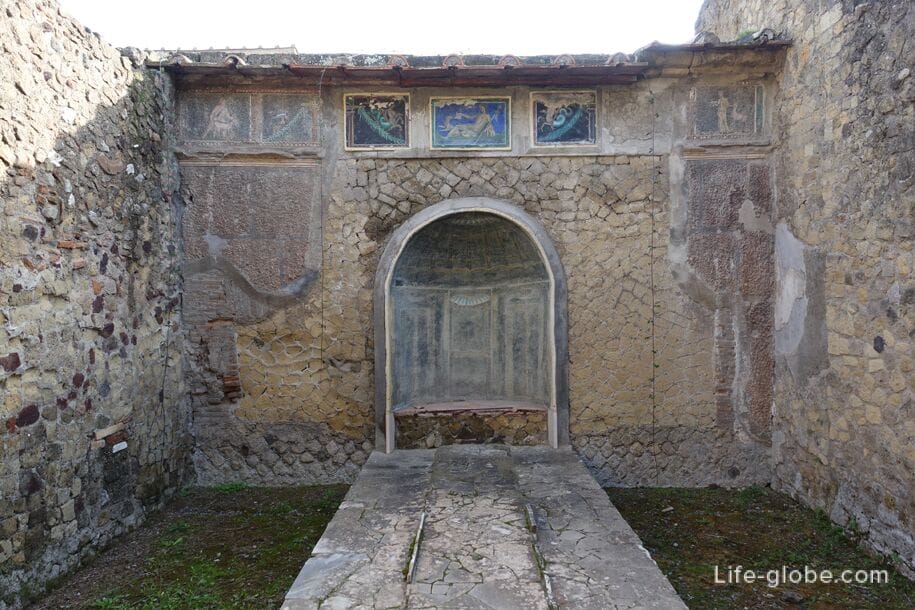
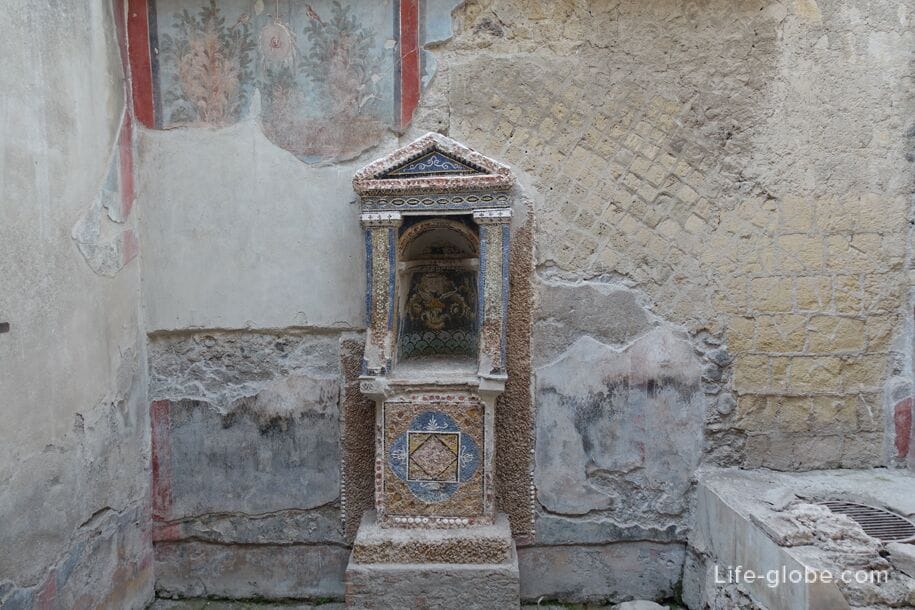
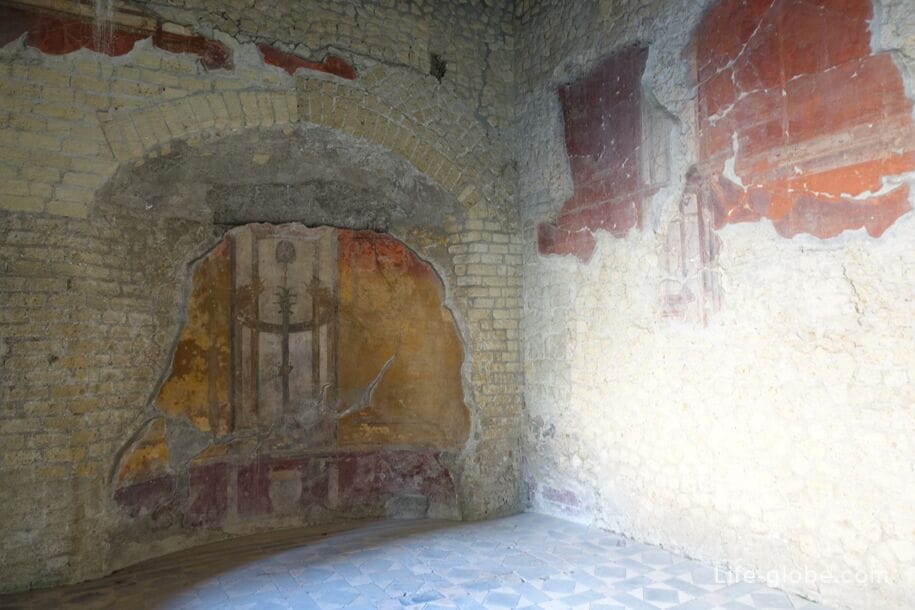

Thermopolia (thermopolium) - Roman restaurants or bars, where was served a hot meal and wine with spices. Thermopolia were often small rooms that went counter to a public street.
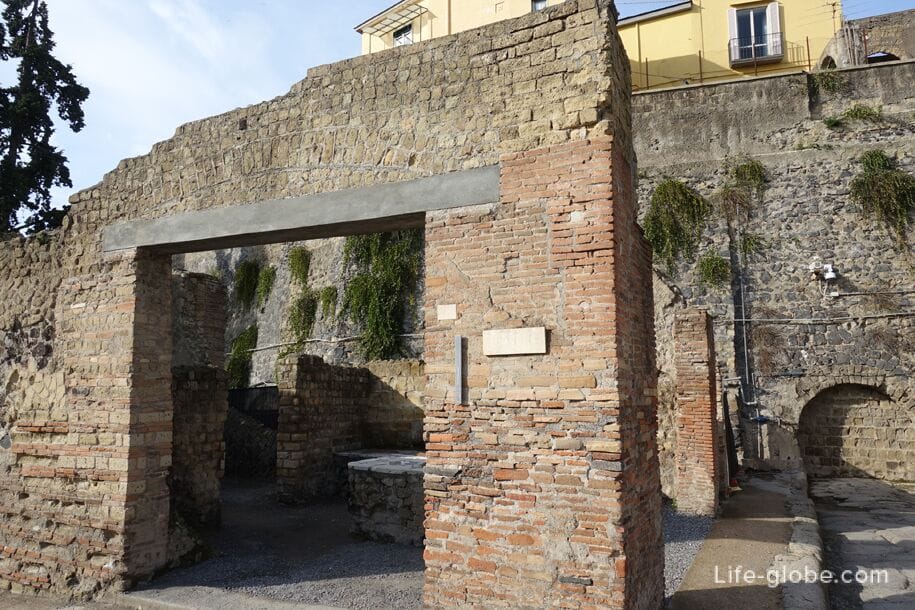


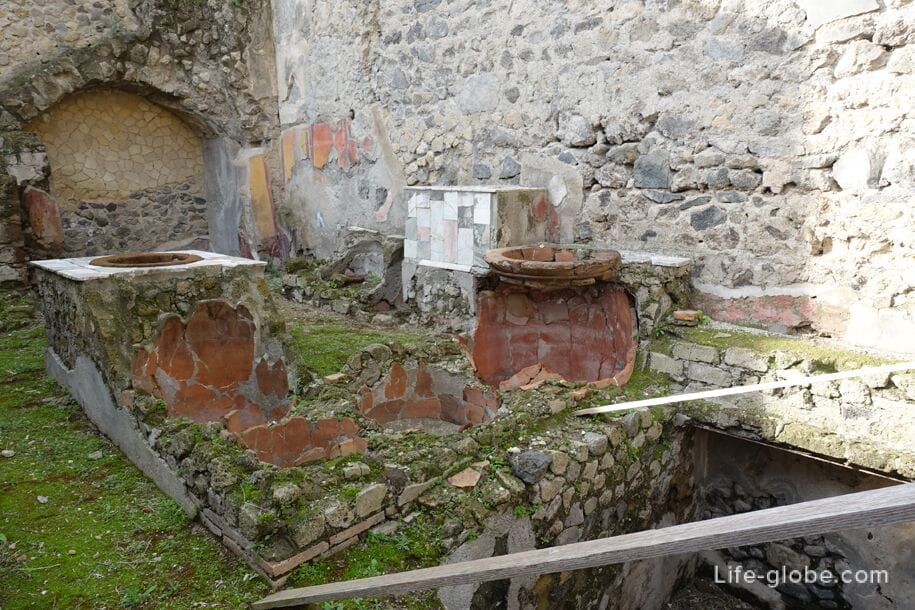
The shop (bottega di c. messenius eunomus).
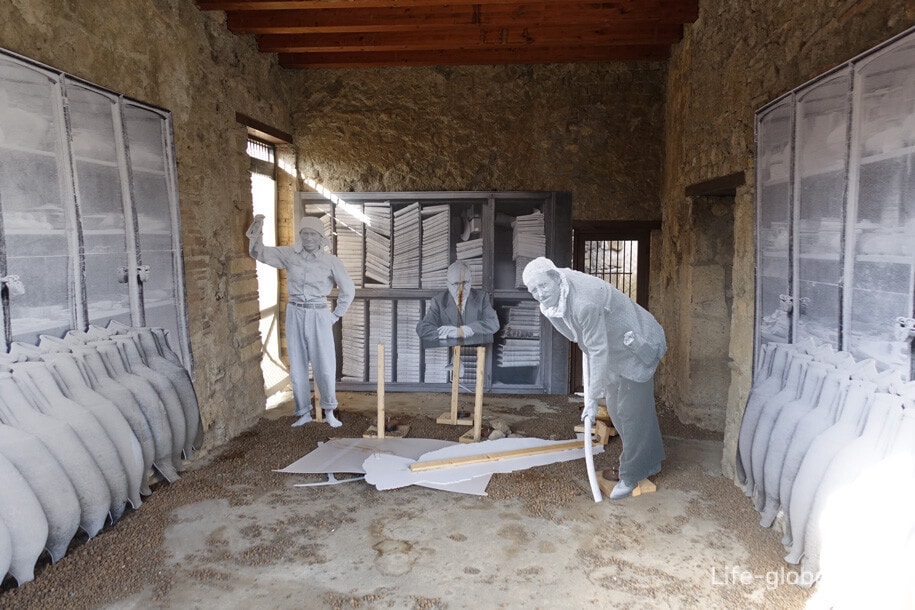
Galda's house (Casa di galba) in a few rooms, with the remains of the atrium, columns and frescoes.
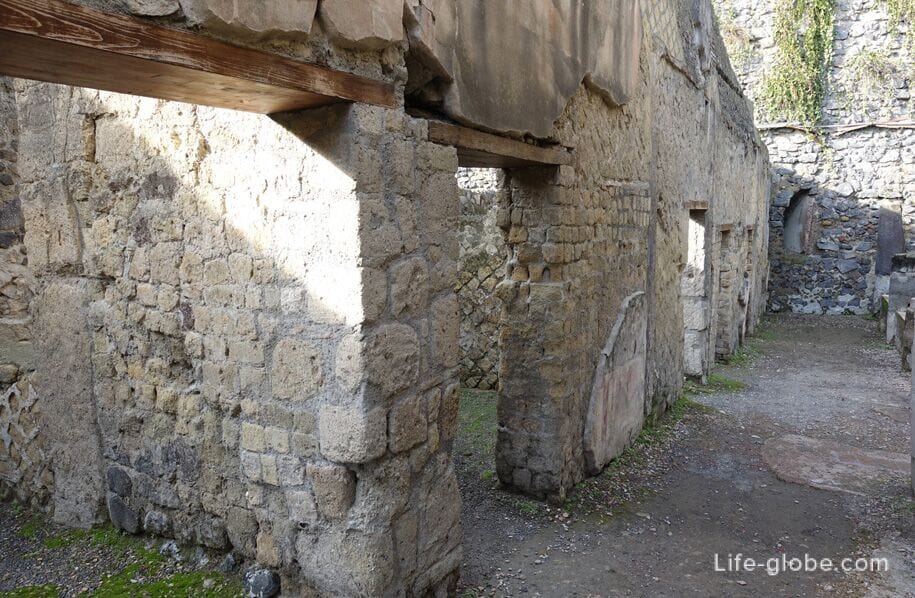


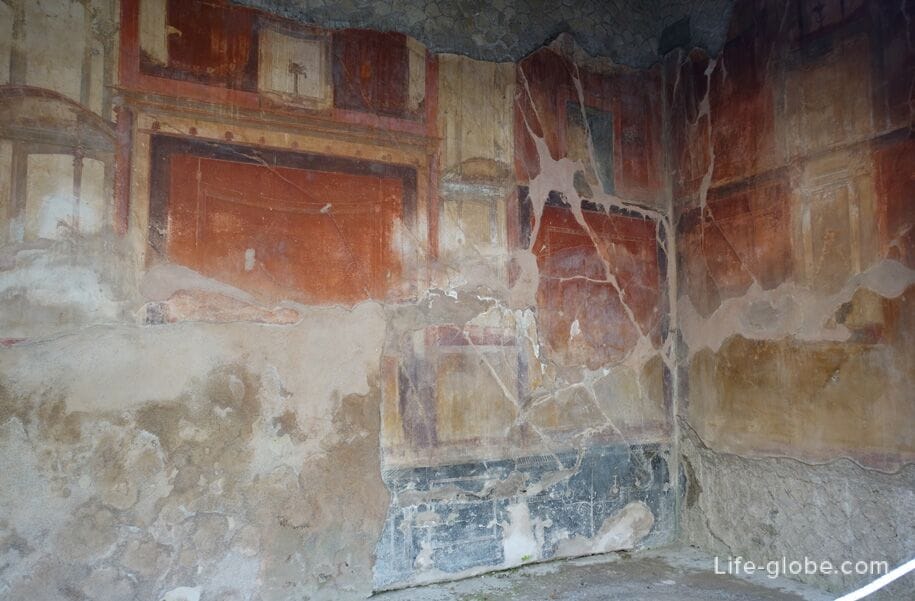
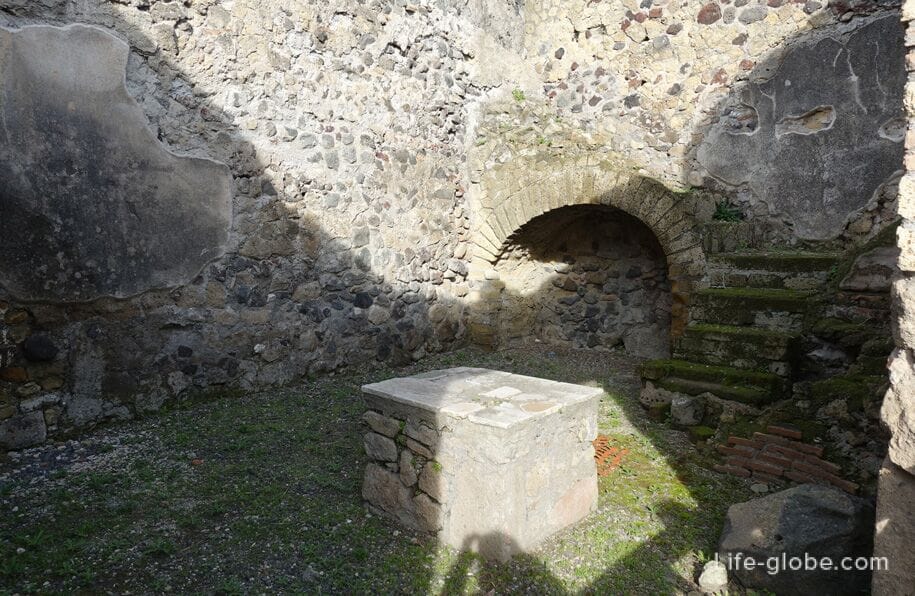
House of two rooms (casa dei due atri) with an atrium and several rooms.

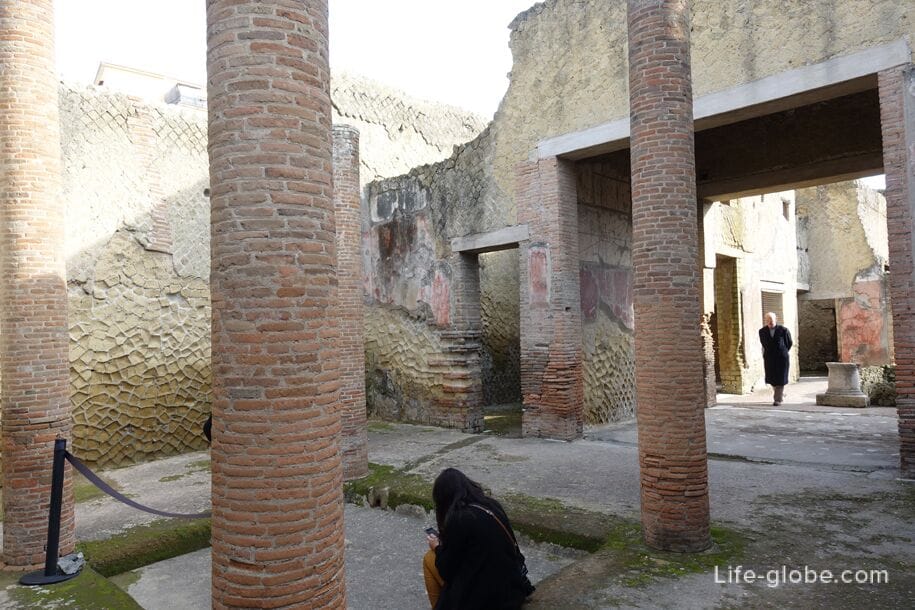
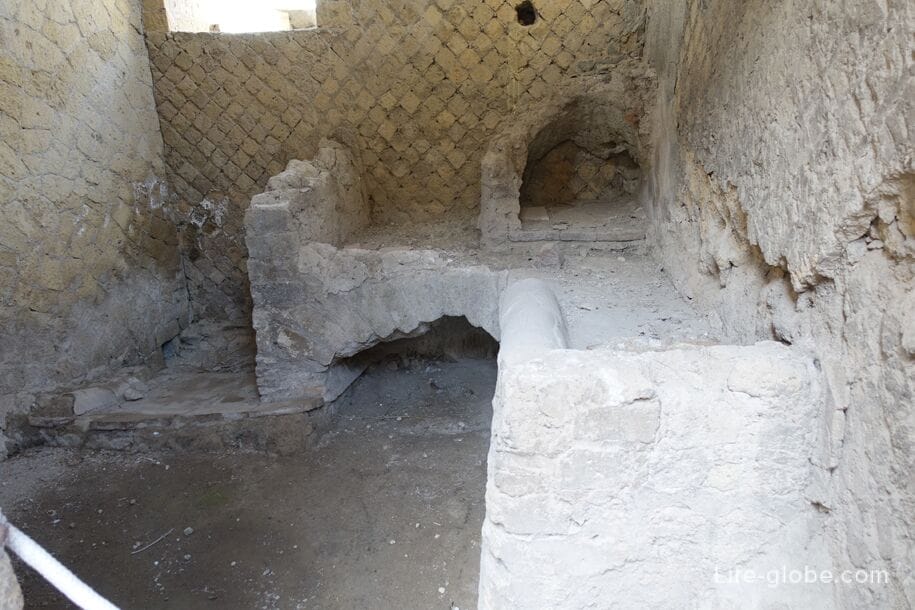
House of the Tuscan colonnade (casa del colonnato tuscanico), a remarkable peristyle, surrounded by a covered colonnade of the Tuscan order.



A small rectangular chapel (Sacello) with a podium in the wall.
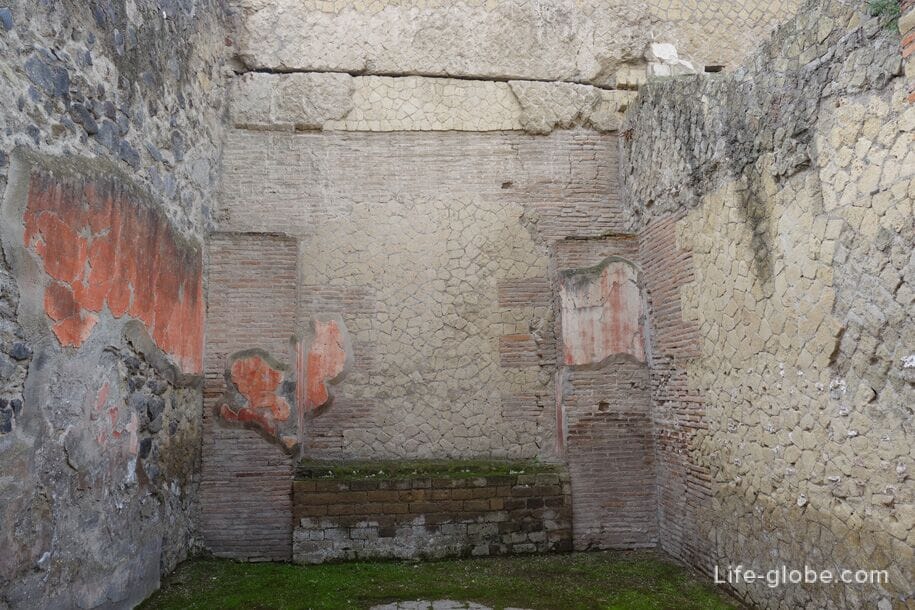
House with a black room (case del salone nero) is one of the luxurious mansions of Herculanum. The atrium has a mosaic floor in black and white.

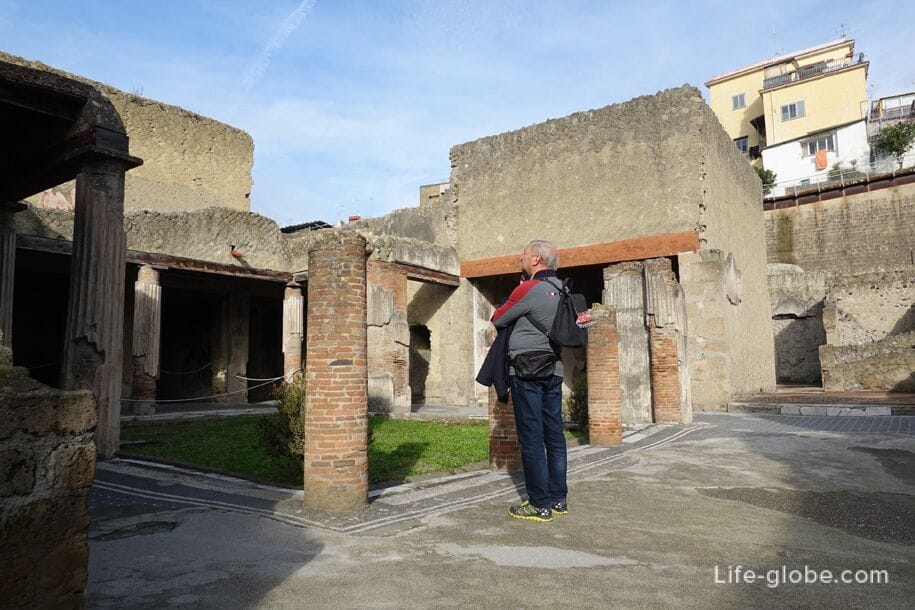
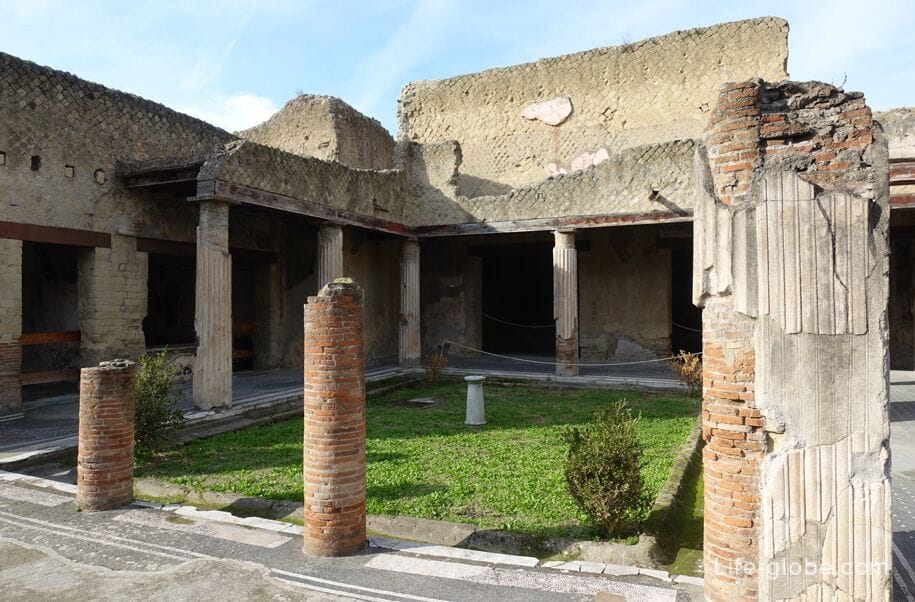
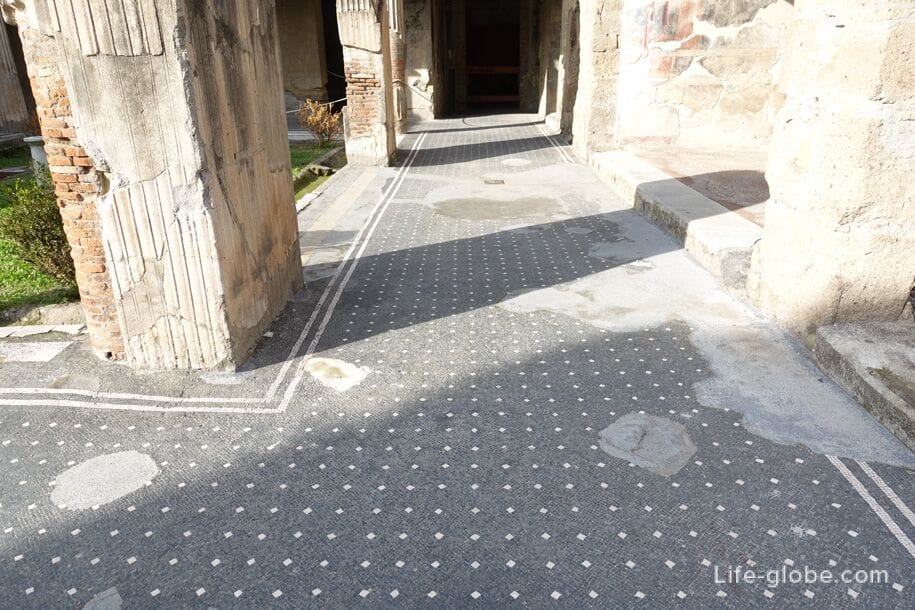
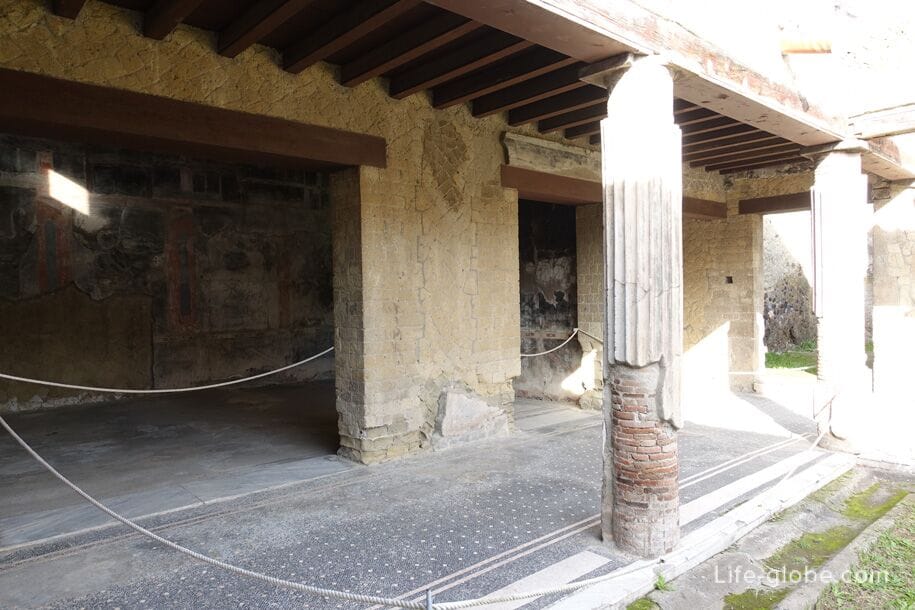
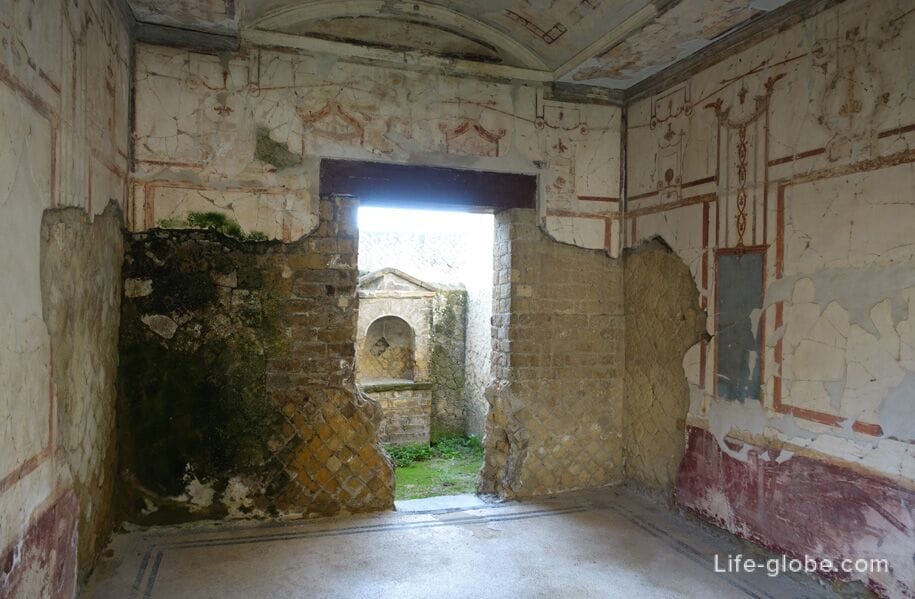
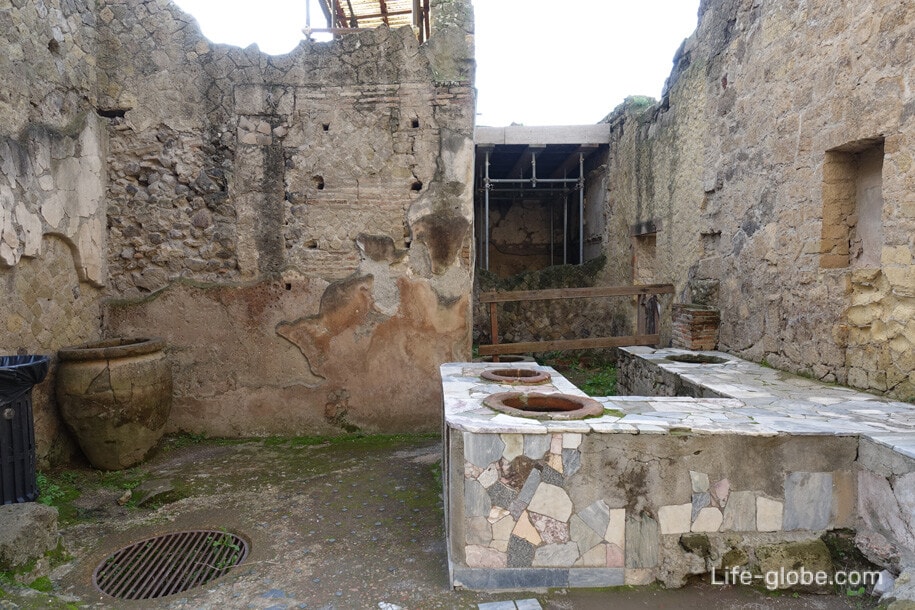
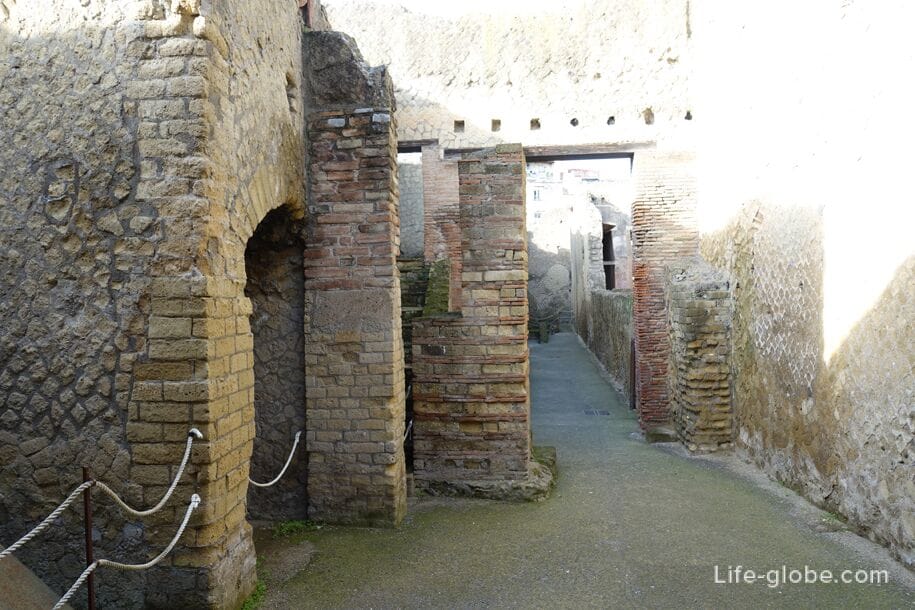
House with a nice yard and preserved staircase (case del bel cortile). Currently in the house there is a small exhibition stand.


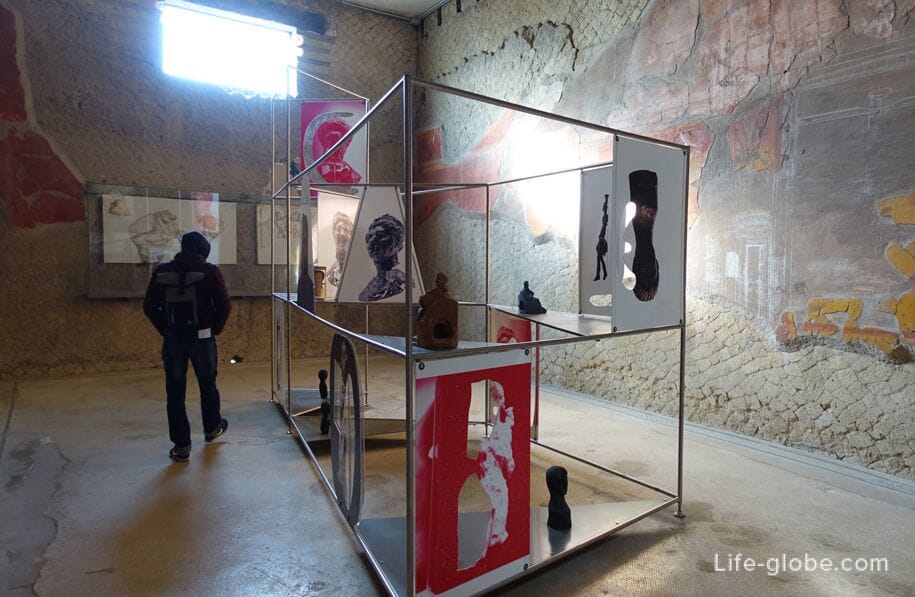

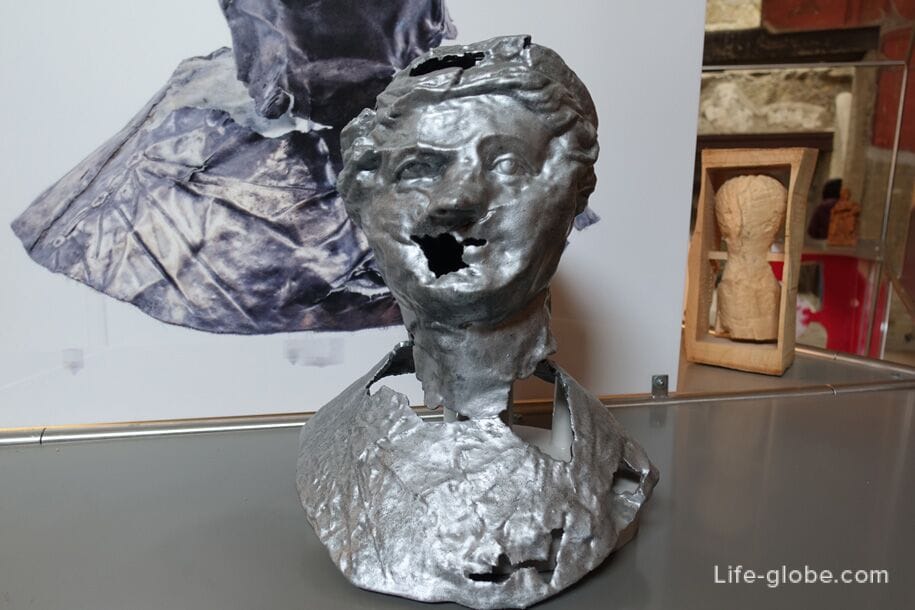
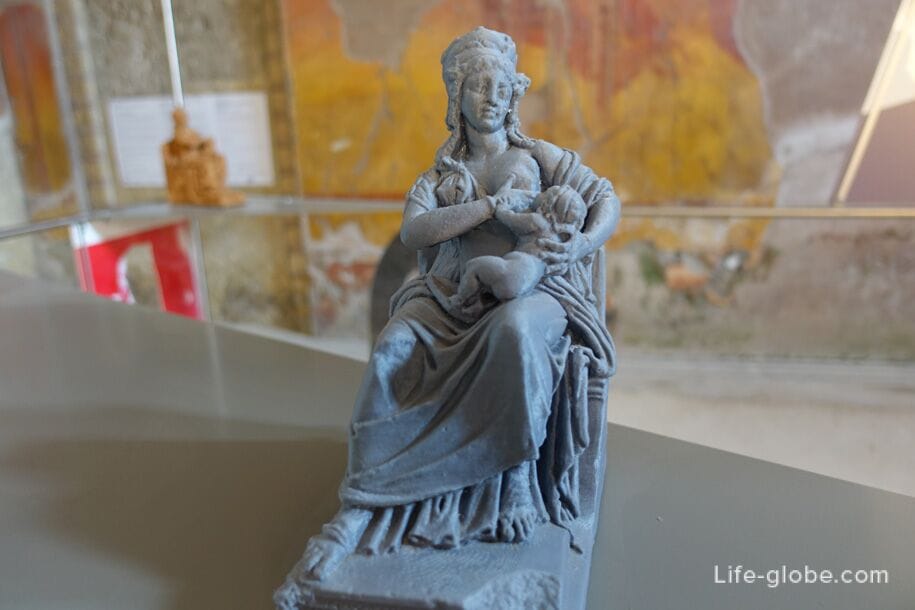
House of Neptune and Amphitrite (case di nettuno e anfitrite), which are partially preserved colored mosaics and wall paintings. This house is known primarily for the outstanding summer triclinium with a Nymphaeum decorated with coloured mosaics.
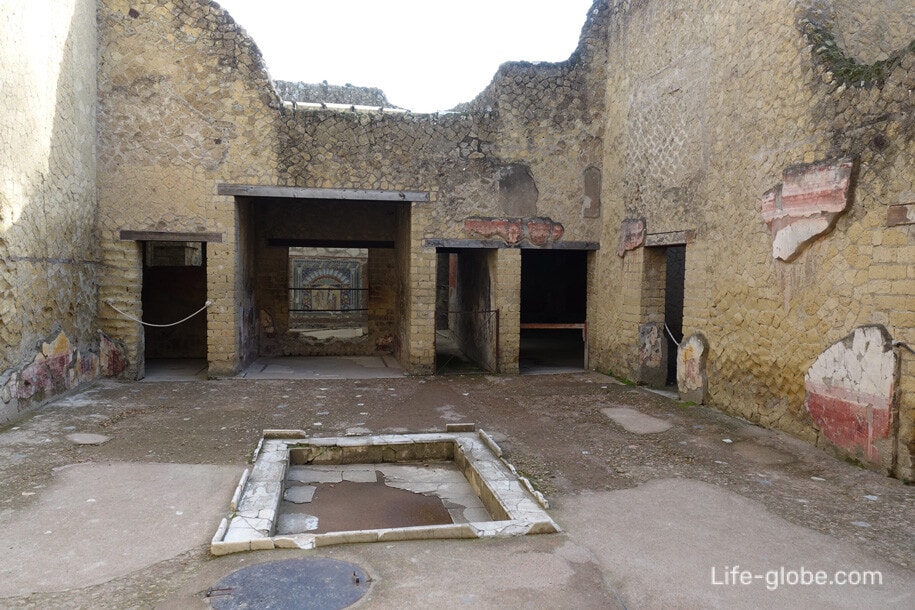
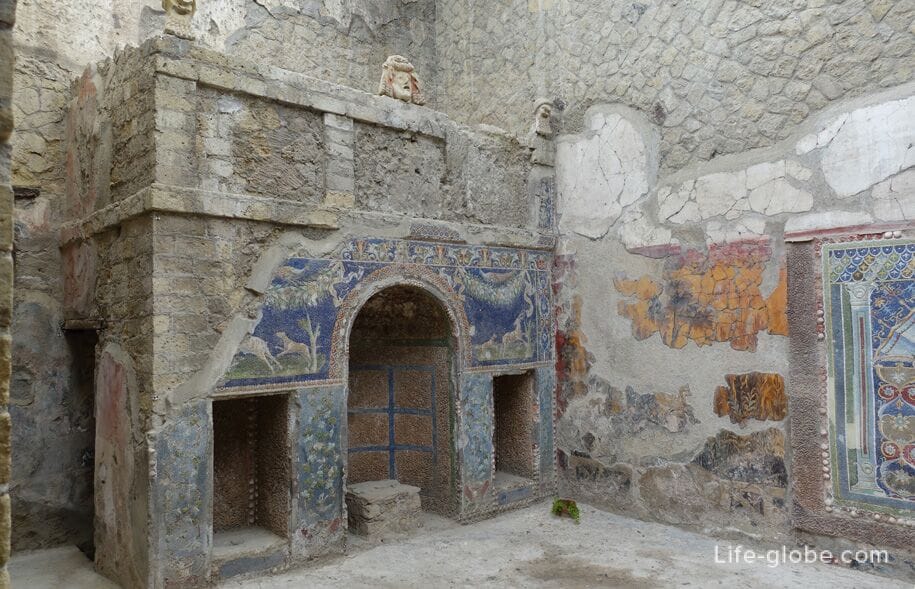
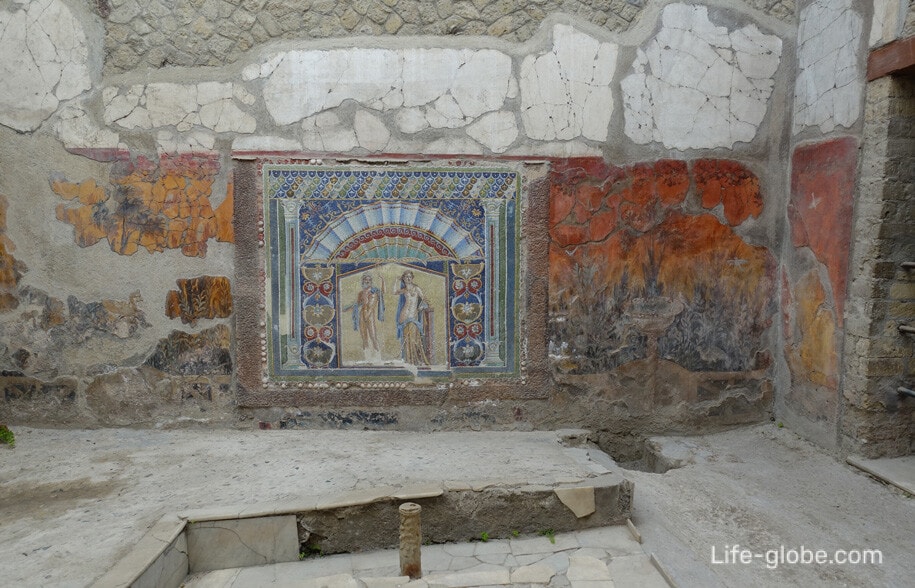

House of Neptune and Amphitrite, probably belonged to a prosperous merchant, wine shop which was located in the adjacent room. The shop itself is well preserved, including wooden shelves and amphorae, in which many years ago used to keep the wines.

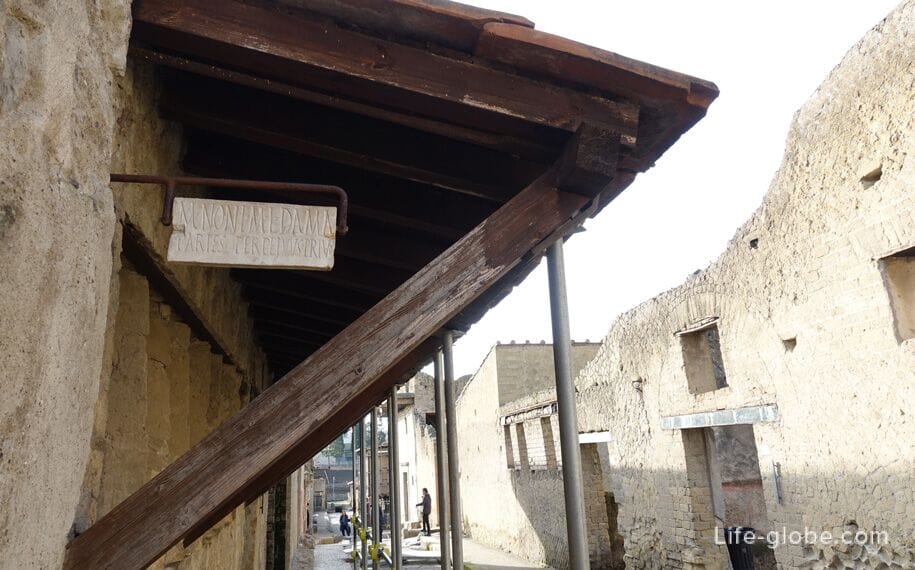
Samnite house (casa sannitica) - one of the oldest buildings in the town dates back to the late 2nd century BC to the second floor Balcony rests on Corinthian columns of tufa. Also remains of frescoes and mosaic floor.
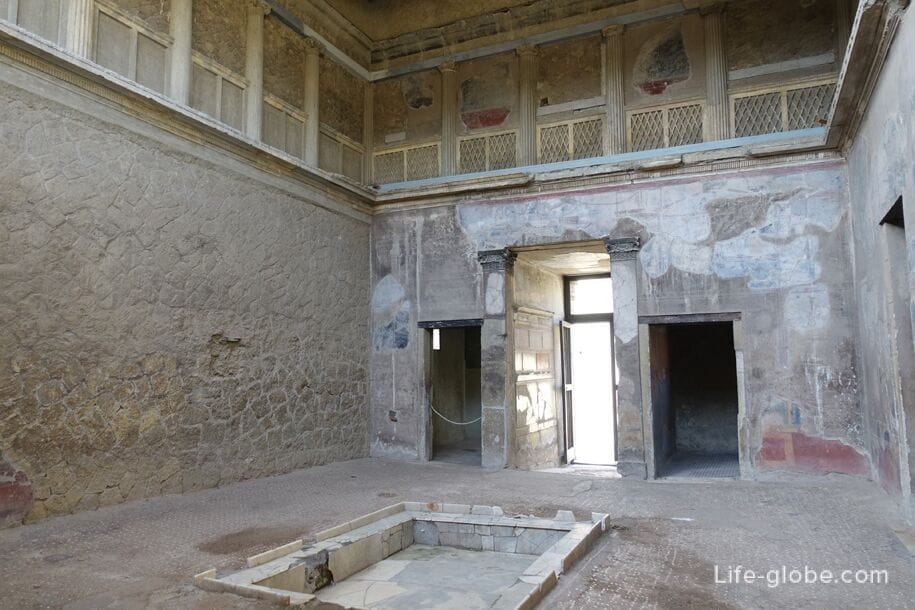
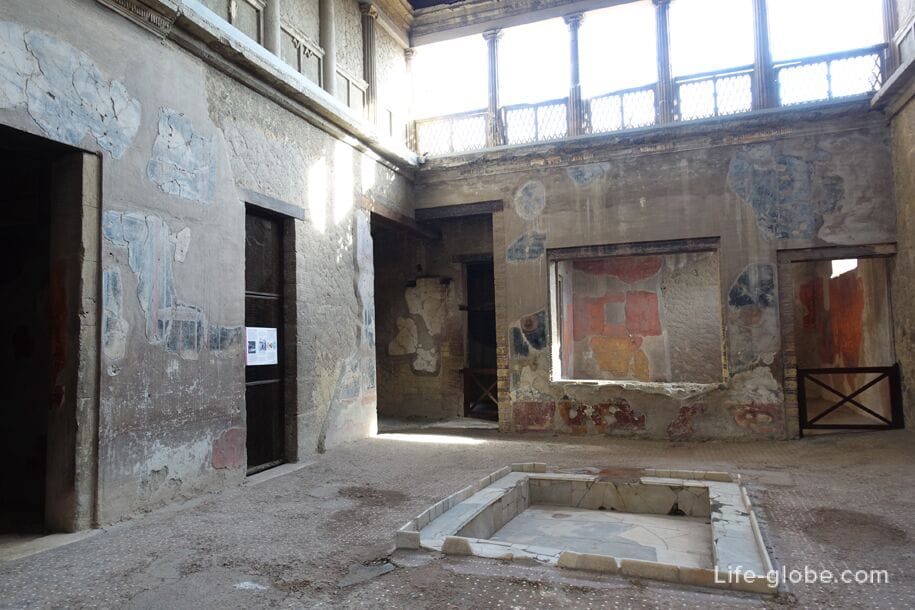
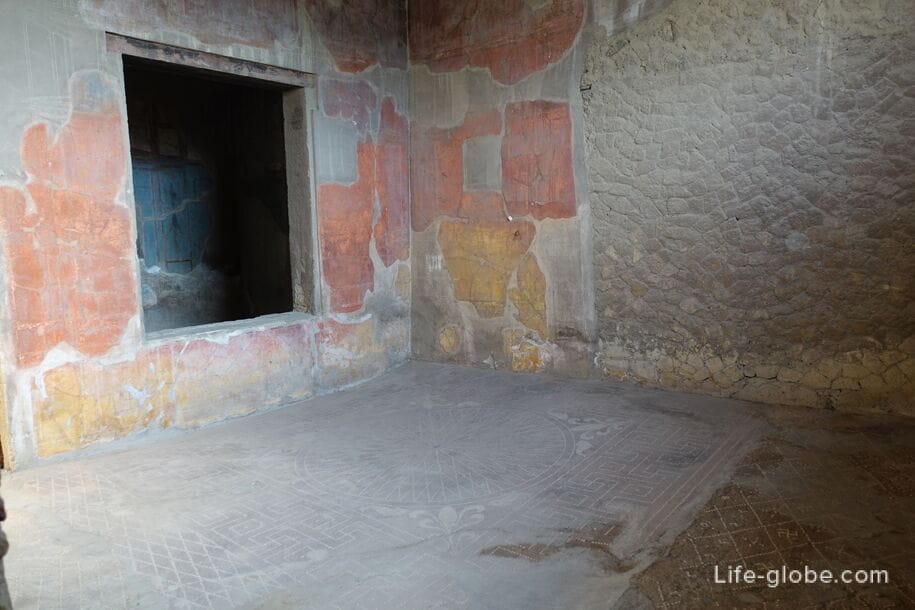
House with a wooden partition (casa del tramezzo di legno), in which the most notable are the surviving wooden partition, and a spacious atrium with impluvium in the center.

The house of papyrus (papiro casa del dipinto).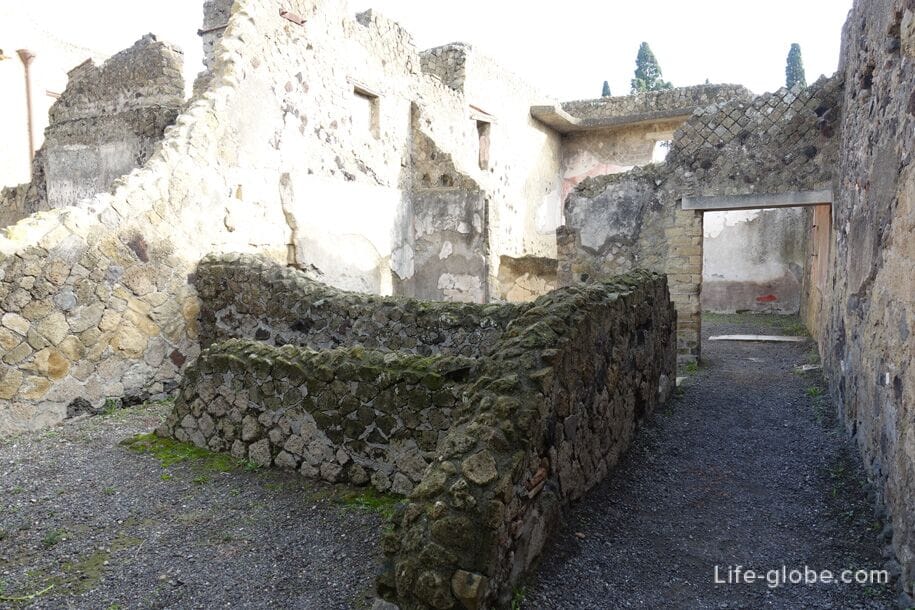 Fullonica house (casa della fullonica) - ancient Laundry.
Fullonica house (casa della fullonica) - ancient Laundry.
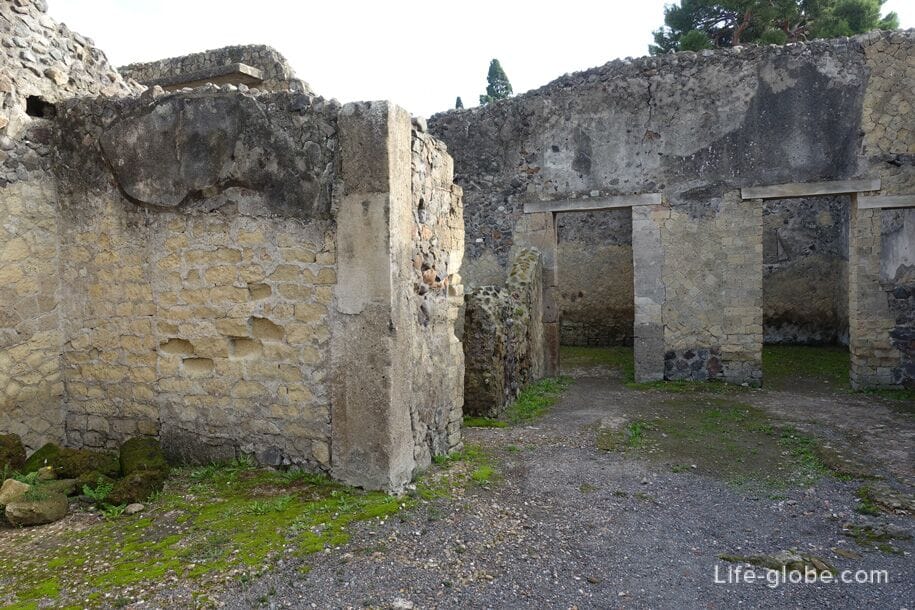
House of the Alcove (casa Dell'alcova), consisting of two buildings connected together. As a consequence, the house is a mix of simple rooms combined with the rich decoration. Here are preserved the columns of the partial mosaic tiles and colorful murals.
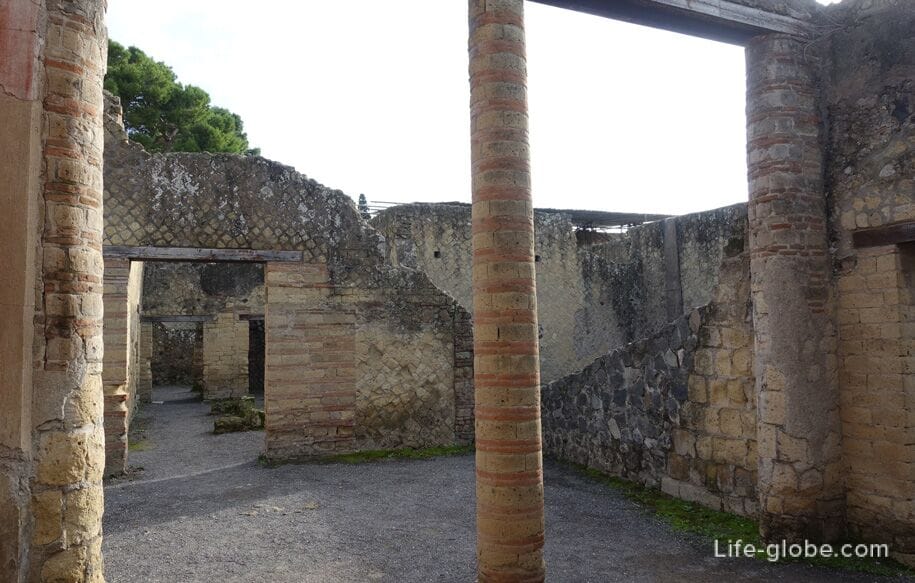



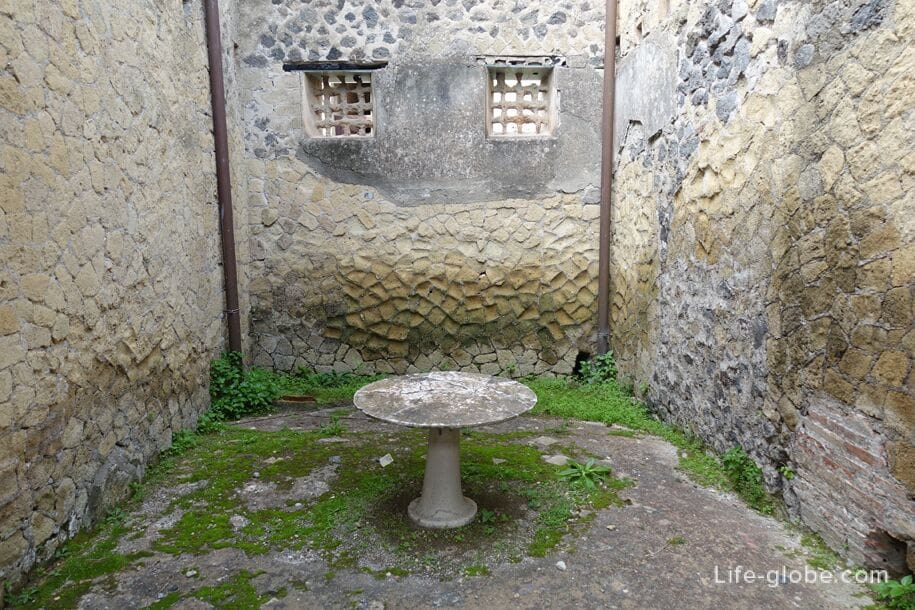

The bronze house (casa Dell ' erma di bronzo), named in honor of the bronze Herm (square pillar, finished sculpted head), found in tablinum - room, intended for storage of documents and meetings - and, presumably, is a sculptural portrait of the owner.
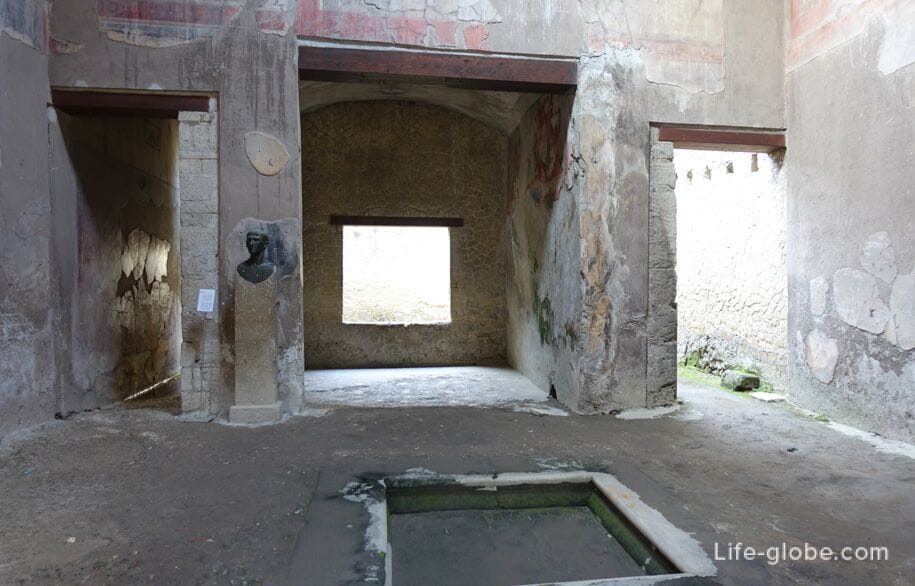
The house with the mosaic atrium (casa Dell ' atrio a mosaico), one of the well-preserved houses of Herculaneum showing all the old charm of mosaic atriums and coloured frescoes.
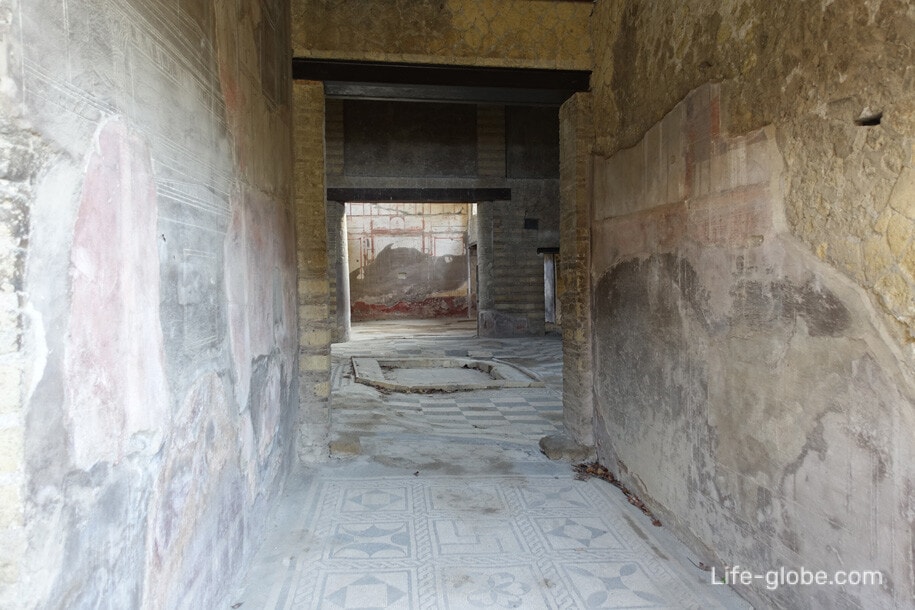
Basilica Nonyana (La basilica Noniana).
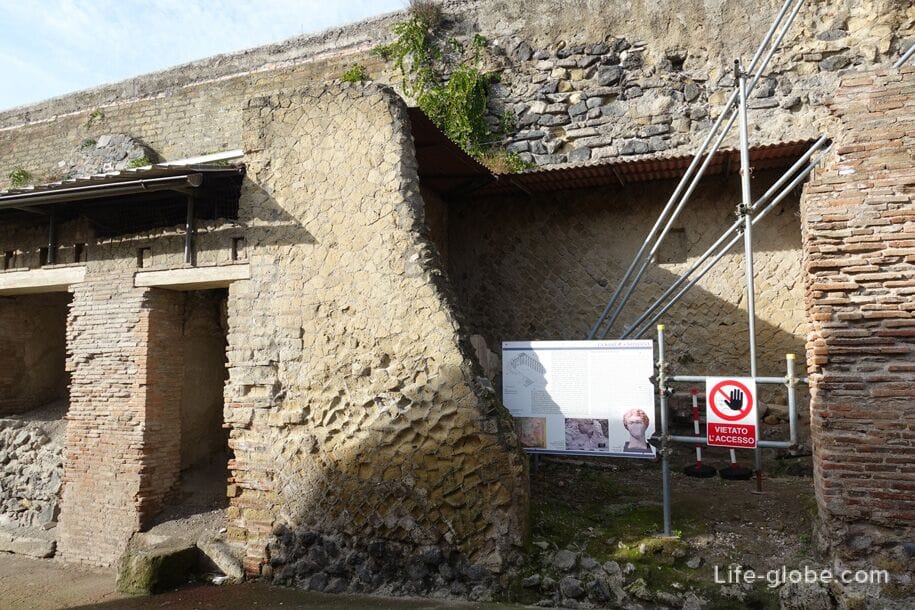
College Augustana (sede degli Augustali) / Temple of Augustus or priests of the Imperial cult.
Augusta were members of the order, consisting of wrestlers dedicated to the Imperial cult of ancient Rome identified emperors and some members of their families with the divinely sanctioned authority (auctoritas).
The Imperial cult was inseparable from the cult of the official deities of Rome, and therefore the neglect of them was considered treasonous.


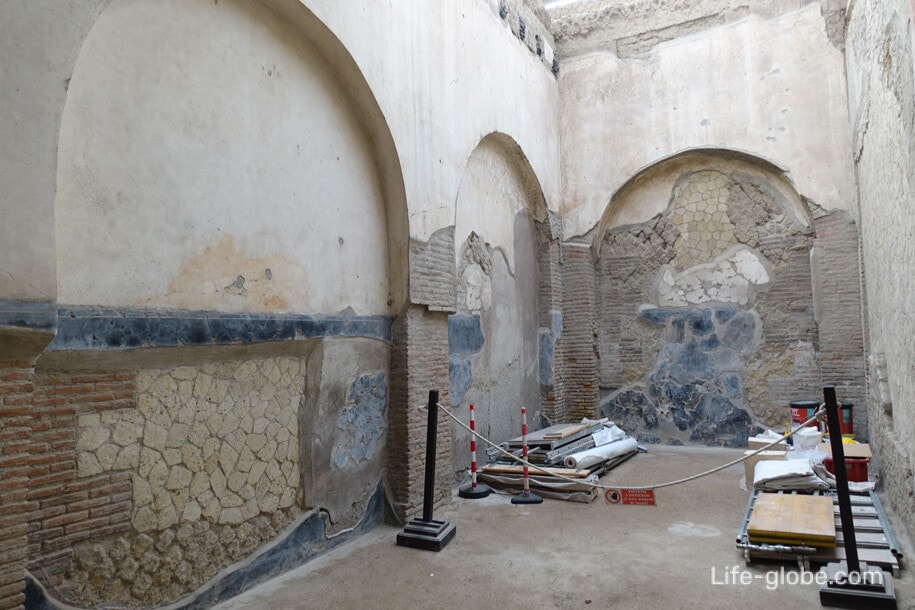

In the ancient cities baths were one of the most visited places among the elite and among the middle class.
In Herculaneum was discovered three large buildings of the Thermae (baths). The first, known as the Terme Centrali, had male and female parts, was built in the first century of our era, and still demonstrate themselves as the bath and making. Been also discovered in the suburban baths, located near the coast of the city, with impressive entrance hall and an interesting and innovative at the time a water heating system with a boiler in the middle of the pool. The same system was used in the third heat the building of Herculaneum, discovered at the North-West side during the excavations in the 90-ies.
The men's Banya (Central baths)
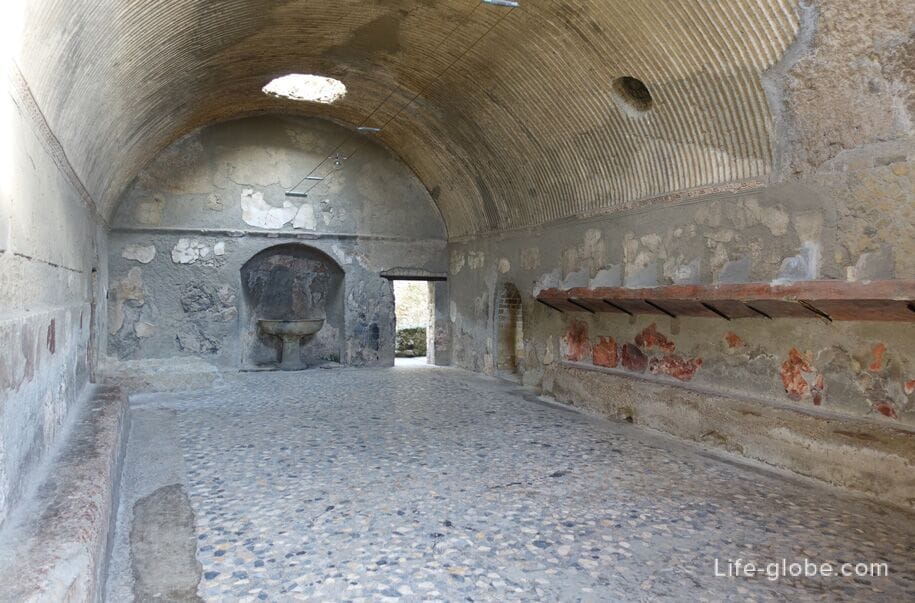
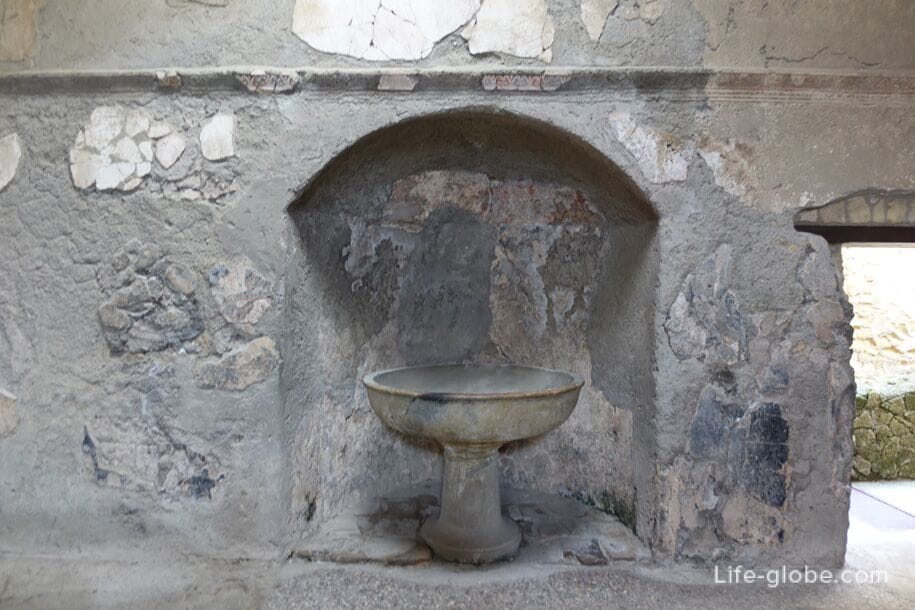
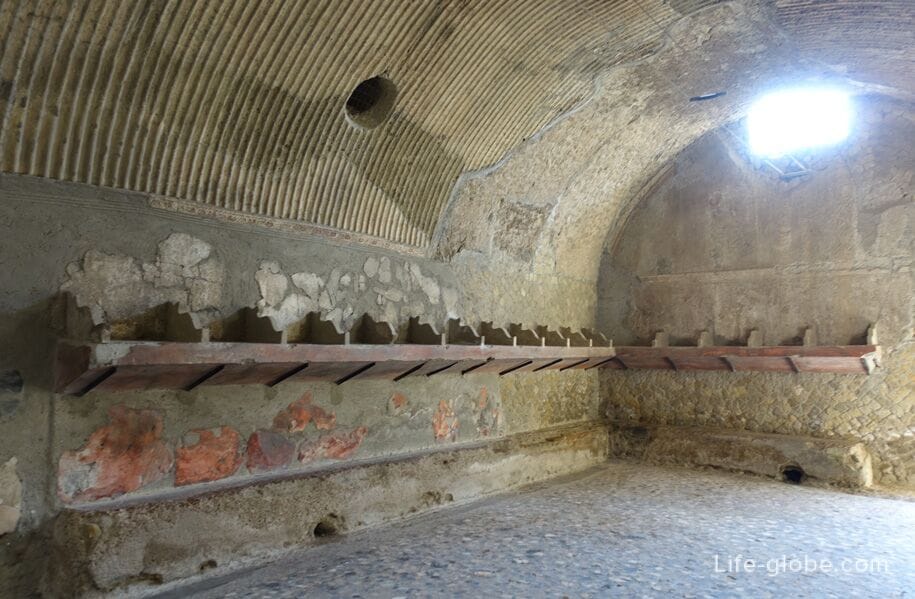
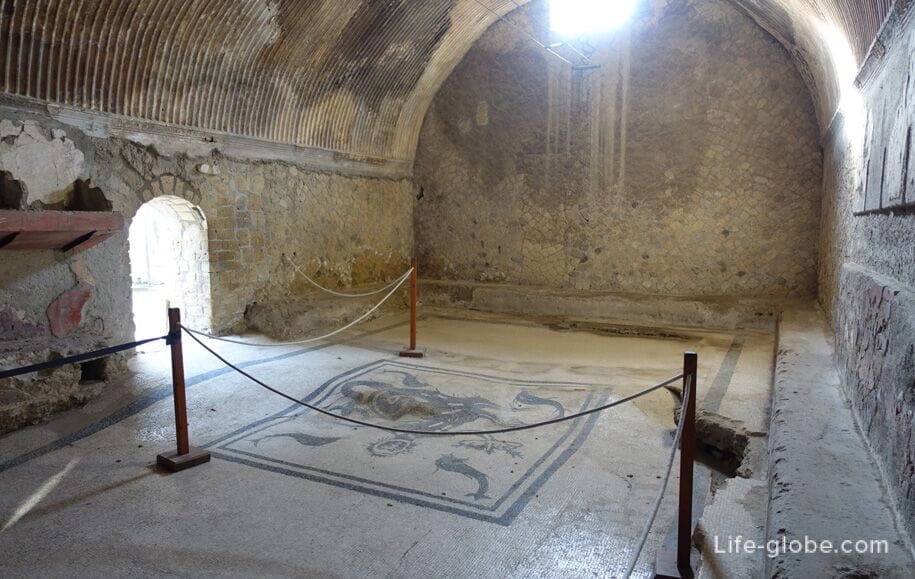
Women's Banya (Central baths)

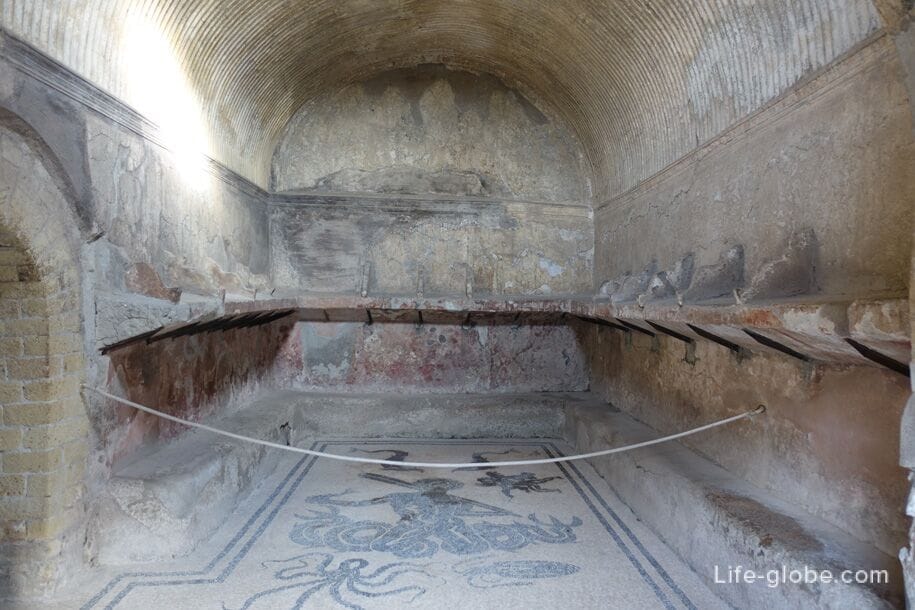
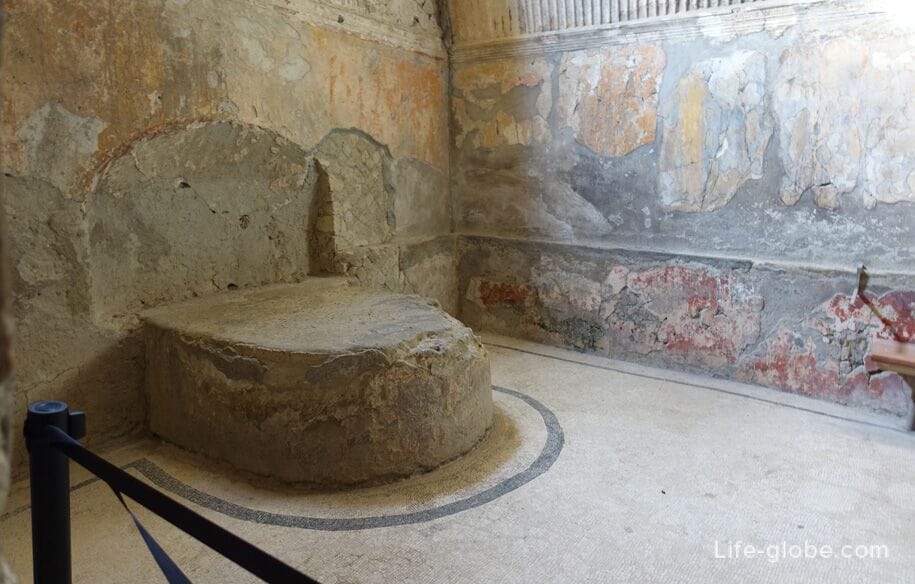
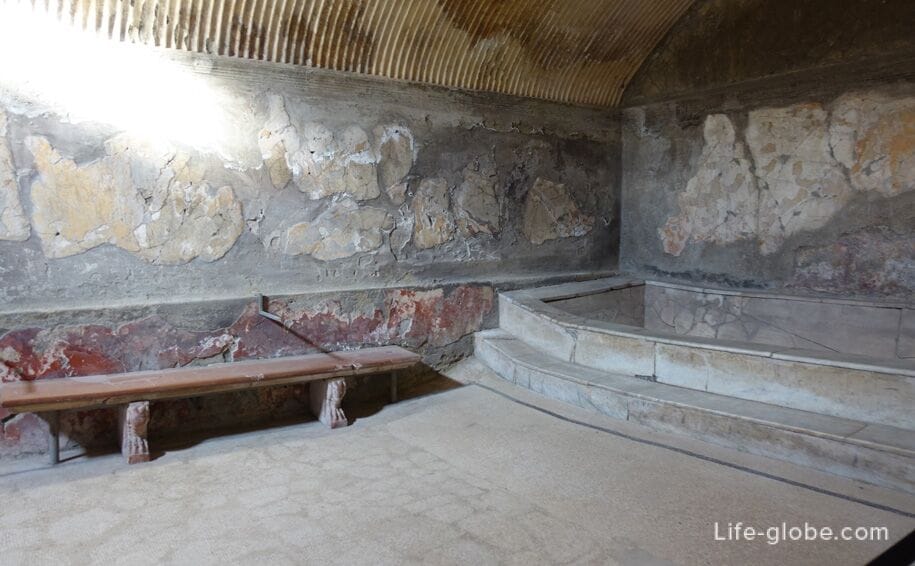
The largest and most important street in ancient Herculaneum was the so-called Decumanus Maximus (Decumano Massimo) - the route connecting the Eastern and Western part of the city. Here was located the city forum (the market), along which were public buildings.


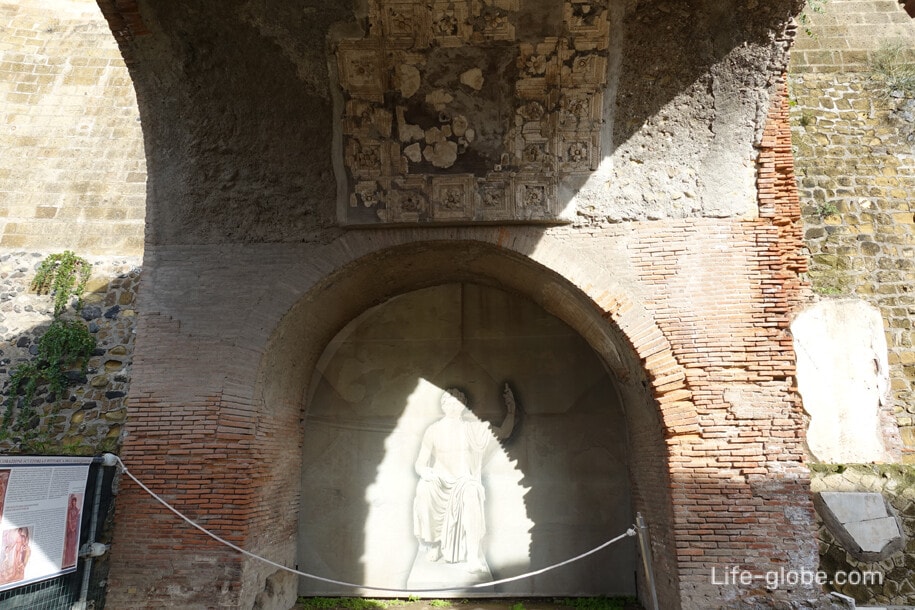
Along the remains of the shops.
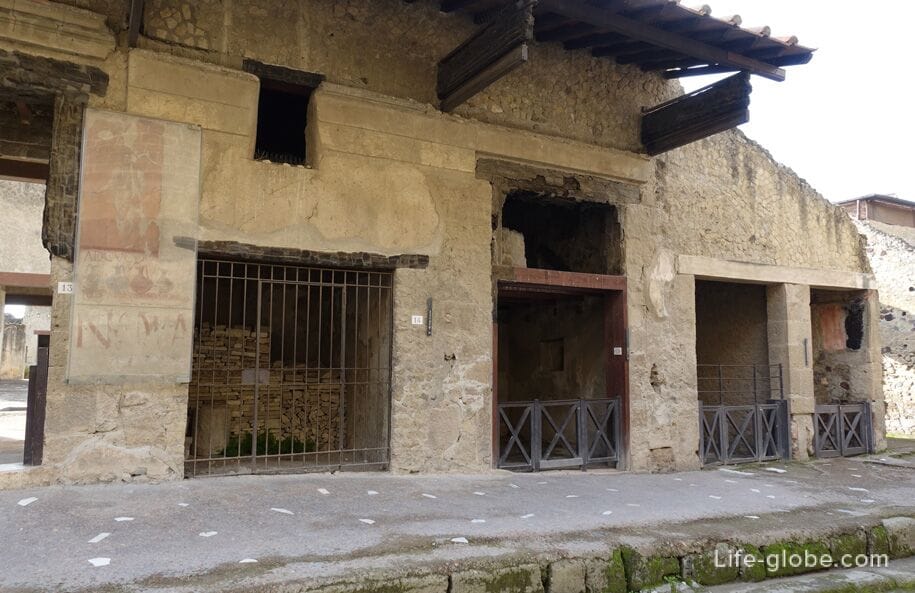
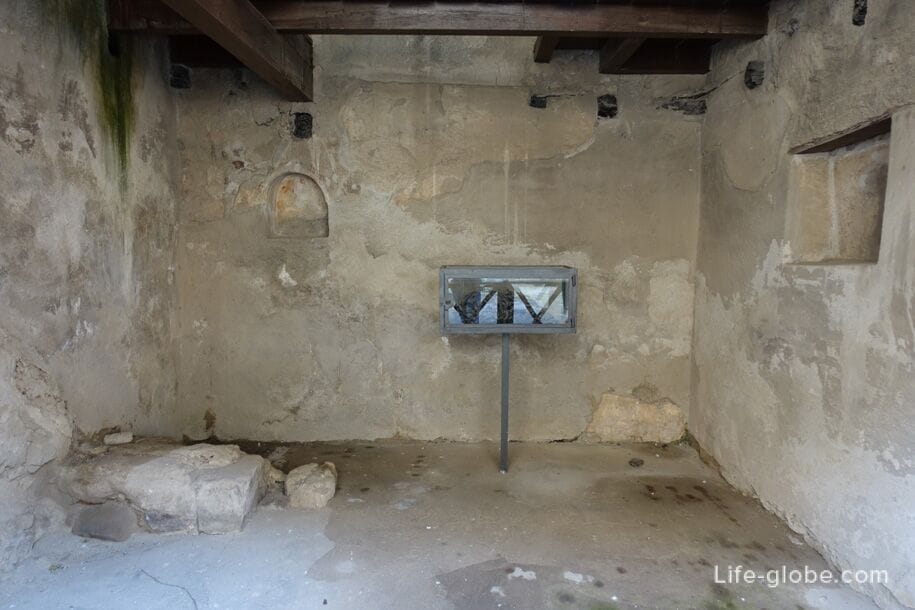

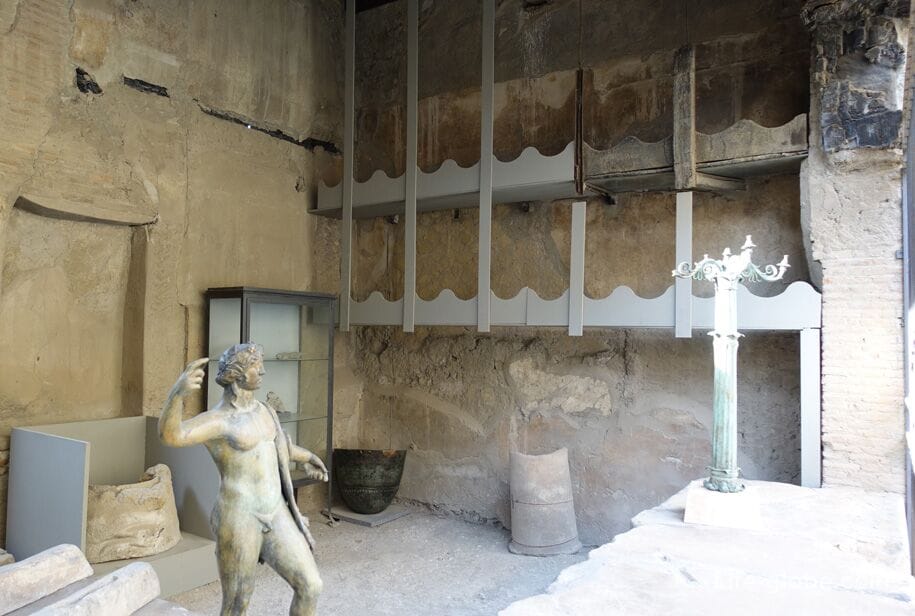
The timber-frame house with balcony (Casa a Graticcio). This is the house with the upper floor intended for multi-family use, built almost entirely of opus craticium technology. Balcony to the street, supported by columns.
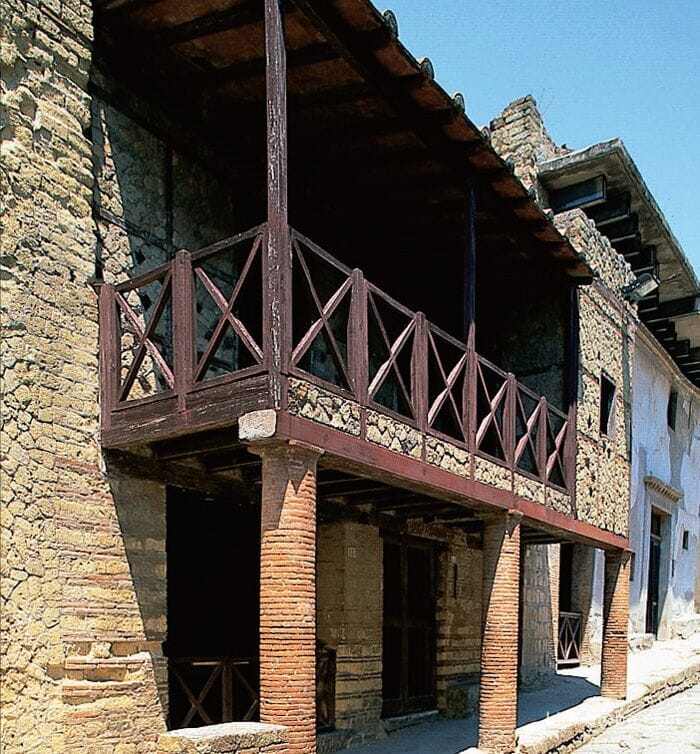
In ancient Herculaneum, you can see the primitive baths , public fountains, which were the meeting place of the ancient Herculaneum. Such fountains were installed on the repainting of streets. It was a small pool made of limestone, decorated with figures of deities, among them of Neptune, Minerva, and Venus. The fountains were fed through a complex system of lead pipes connected to the public aqueduct. These channels were also used to deliver a flow of water in the richest houses of the city, where they had fountains. Excess water flowed through terracotta channels and was used to clean the roads and drains of tubs, then flowed into public sewers, and then into the sea.

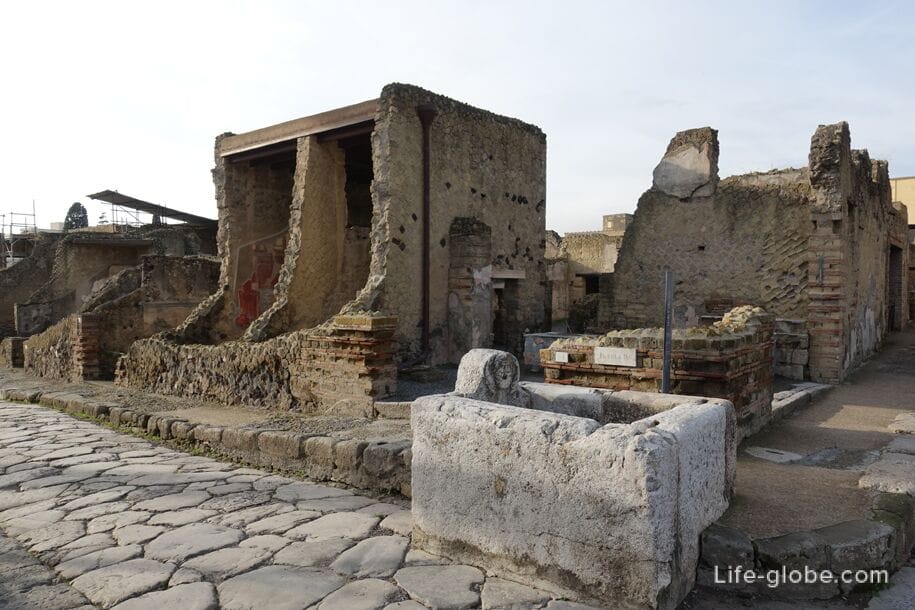
Palestra (palestra) - a gymnasium, - a large complex, designed primarily for educational activities and sport, was erected in the time of Augustus (27 BC). Access was through the monumental vestibule with two pillars, which in ancient times had a vaulted ceiling. The structure was characterized by a large garden with a swimming pool in the centre of a cross. On three sides the garden is bordered by a portico with columns, and on the North side of the vaulted corridor supported the terrace, which housed the rooms.

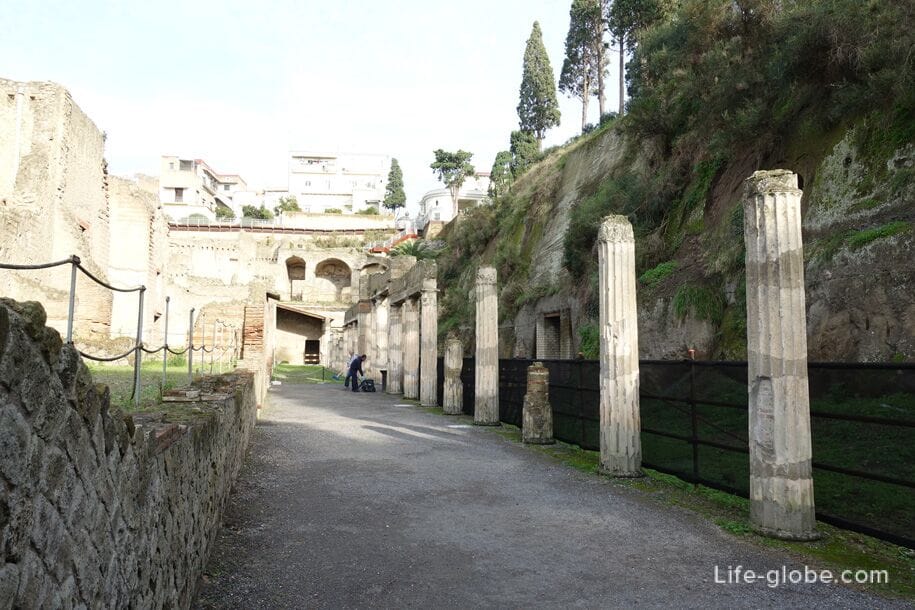
The house of the Grand Portal or a house with a large portal (Casa del Gran Portale), whose name comes from a beautiful portal with half columns, completed brick cornice. In the building are murals, small yard to the left of the entrance and the triclinium.
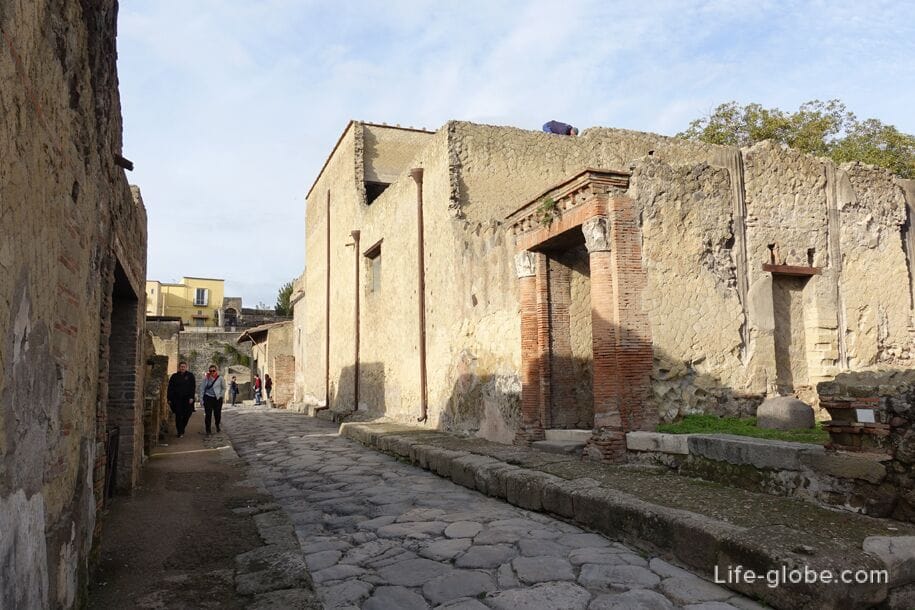
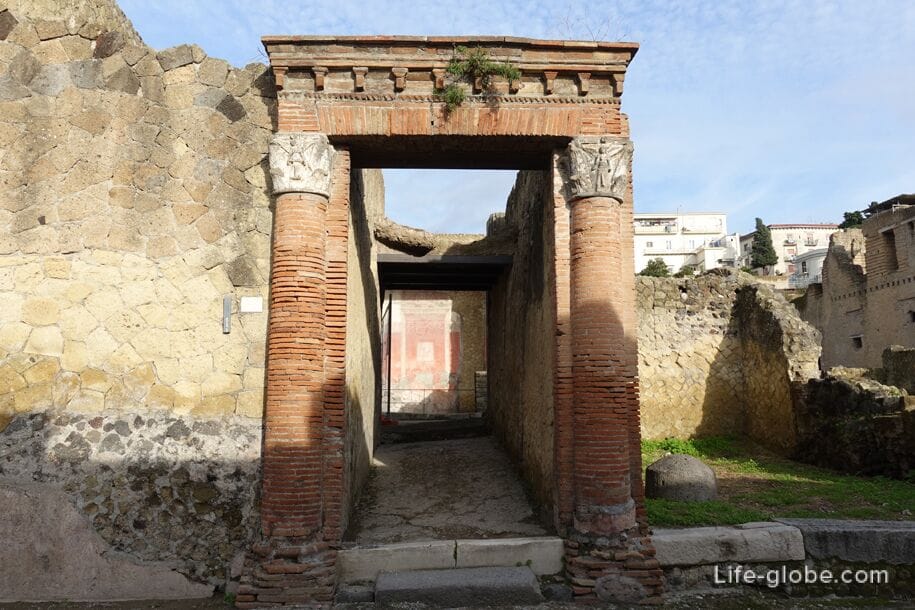
The bakery (pistrinum e Bottega di Sex. Patulcius Felix), which carried out the work on the cycle of bread-making, from grinding grain to baking bread. The patio is still there are two millstones, which, judging from the discovered next to the bones, resulted in the movement of donkeys. In addition, the bakery was a stone oven, a barn and two toilets and on the second floor of the dwelling.
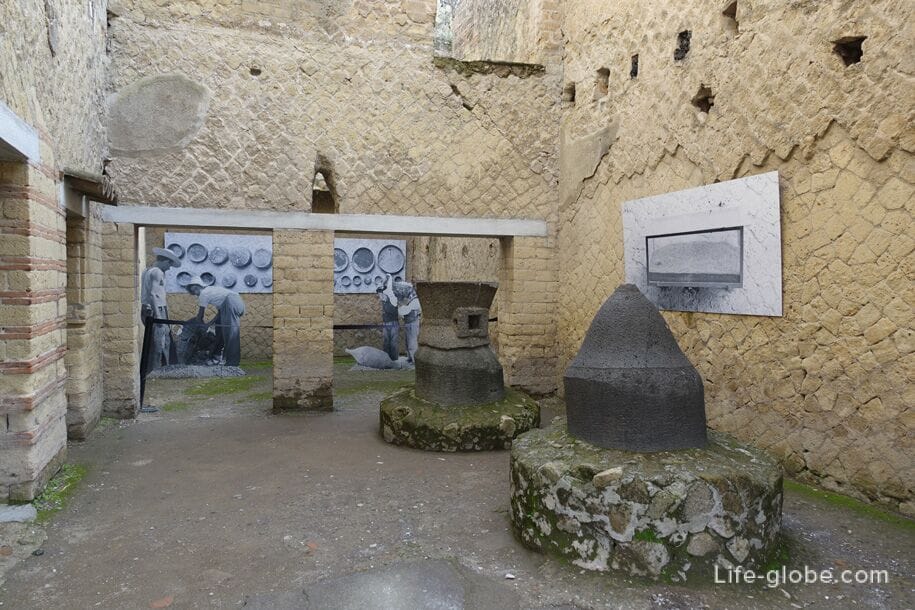
House with garden (casa con giardino). It was a pretty poor, undecorated house with small rooms, but with a quite big garden.
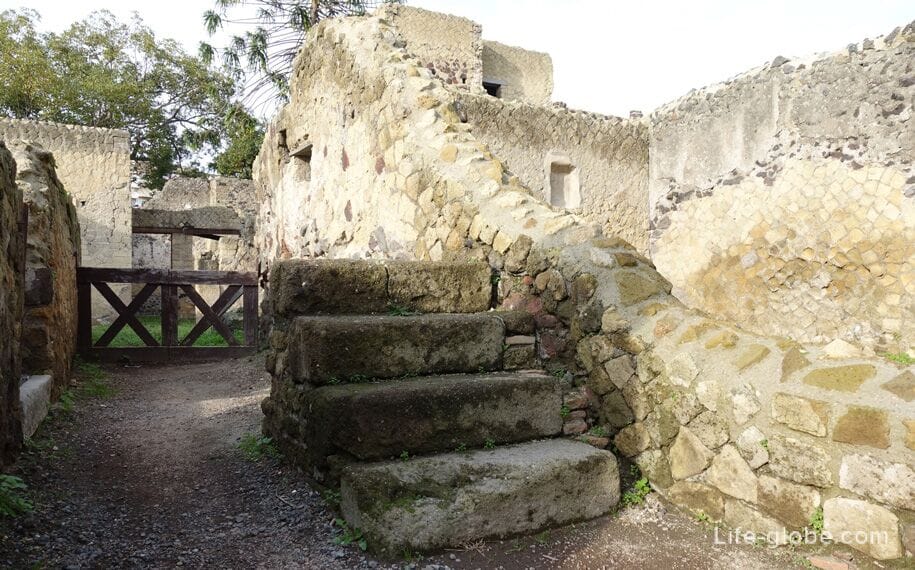
A large tavern (taberna grande).

Tavern of the Priapus (taberna di priapo).
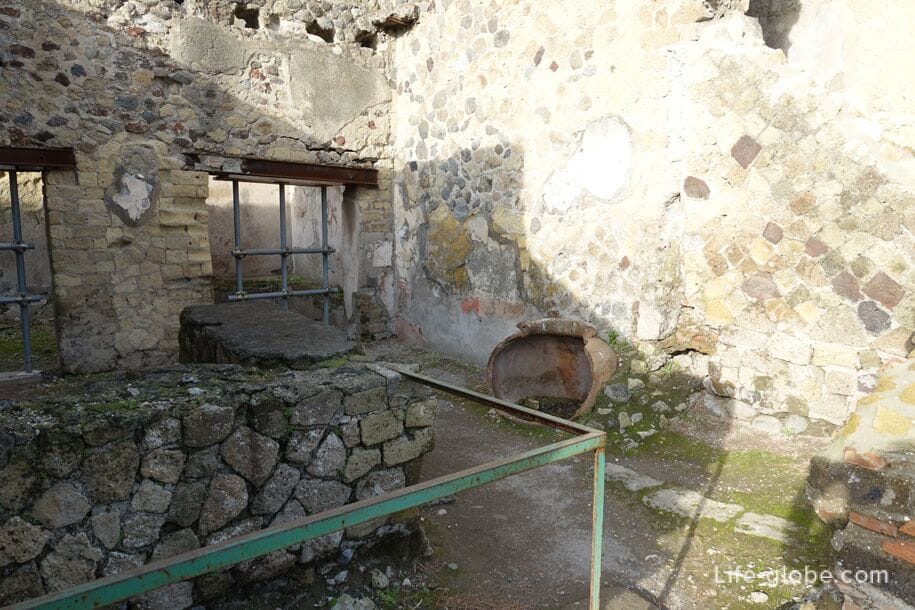
The house with deer (casa dei cervi) is one of the well-preserved, the largest and richest houses of Herculaneum (Villa). The house with the mosaic atrium, a gallery and a room for servants on the upper floor. From the atrium one can get in the kitchen, an alcove and a large triclinium with walls painted with frescoes and inlaid with colorful marble floor.
In the garden house was found round marble tables and the sculptural group with the deer, trapped dogs, and a statue of a Satyr, and statue of Ercole. There is also a terrace with panoramic sea views.



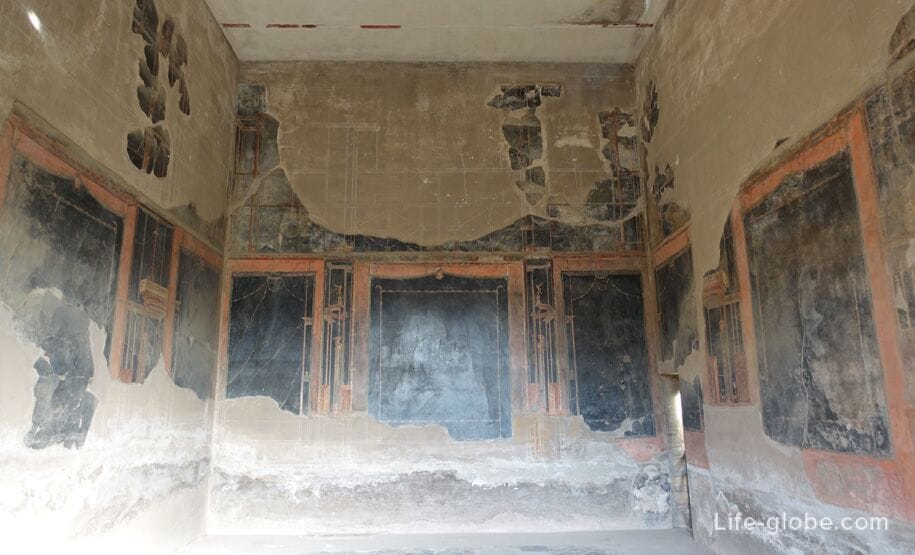
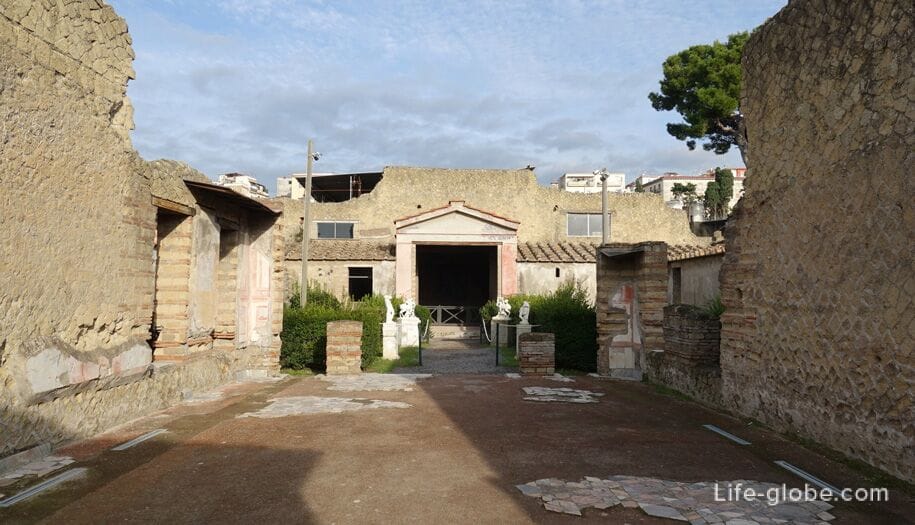
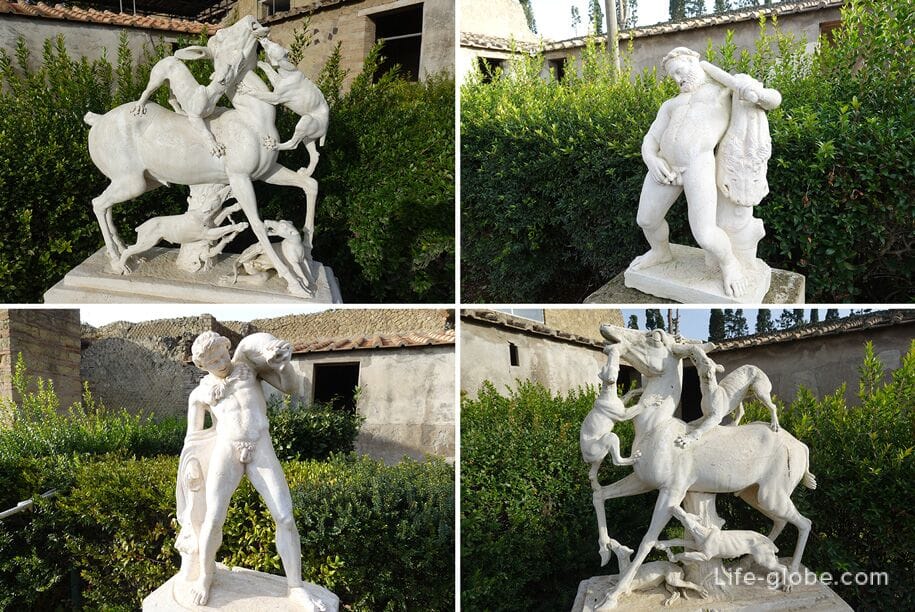



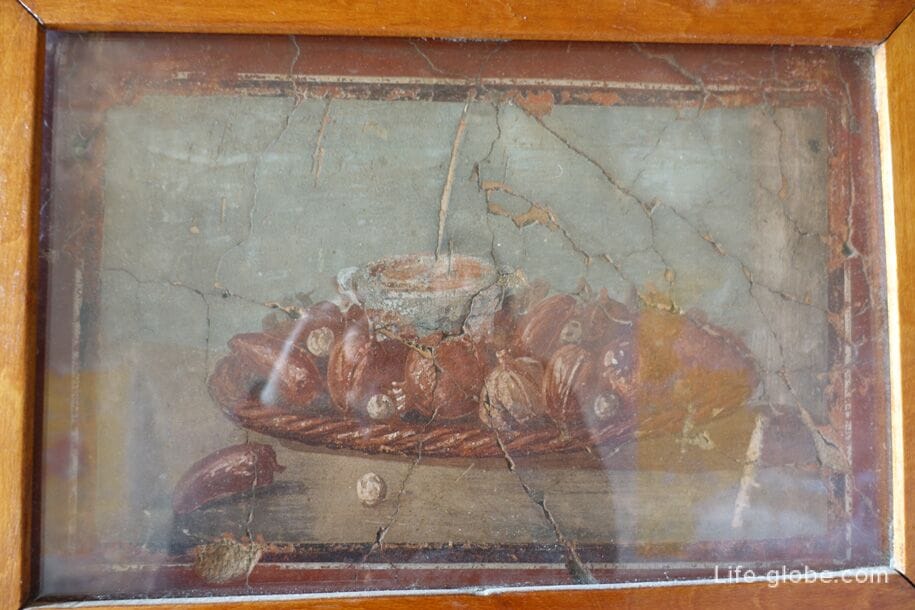
The house with the relief of Telephus (Casa del Rilievo di Telefo). With the neighbouring house it was the second largest complex in Herculaneum (1 800 square meters). The house had a panoramic location and was along the escarpment near the sea. Was built on 3 levels and has a rich collection of sculptures neoakademicheskogo school, including the relief with the myth of Telefo, the son of Ercole (the mythical founder of the city). The current structure dates back to August period (27 BC - 14 ad), with alteration after the earthquake of 62 ad
The columns of the atrium were supported by the rooms on the upper floor, as in certain Greek houses.
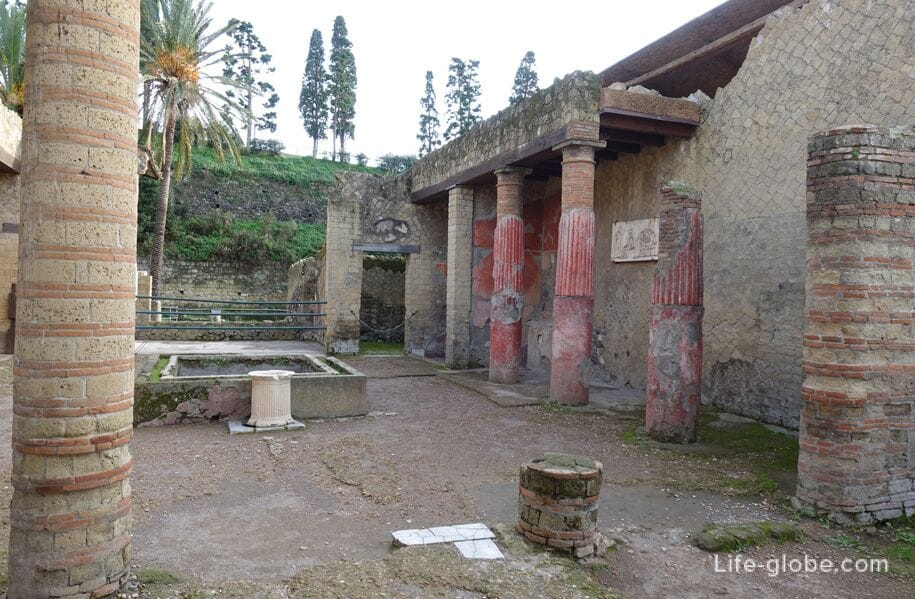


Between the houses with the deer and the Phone is descent, leading the former city walls, once towering above the beach (the ancient coastline of Herculaneum) terraced site.
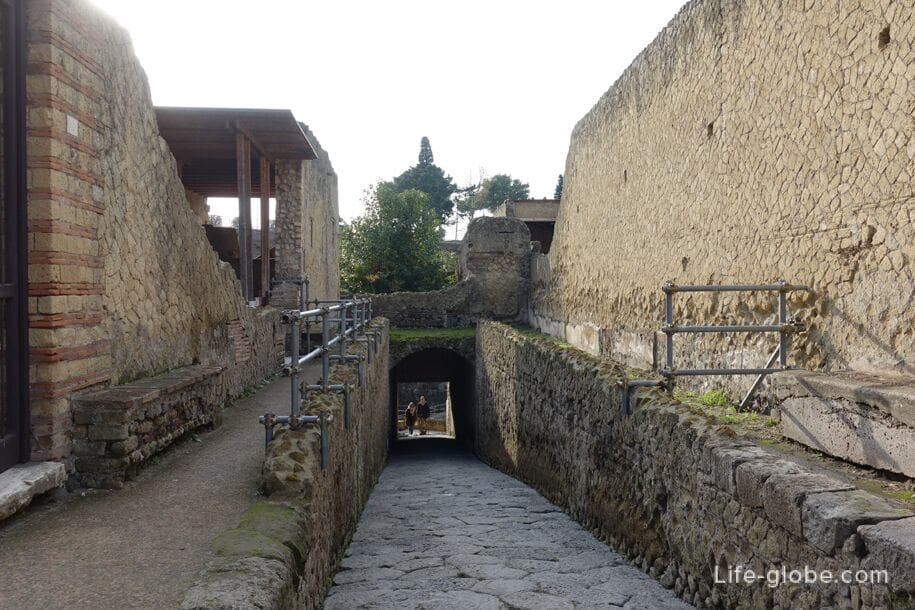

On the terrace there are:
- terrace Nonio Balbo (Terrazza di Marco Nonio Balbo). The funeral altar, covered with marble, which by decree of the local Senate was dedicated to the Roman policy, knight and proconsul of Marco Nonio Balbo, famous for his contribution to the town in the restoration and construction of public buildings. After his death, the city has included Marco in the number of his patrons and gave him honours in the form of several statues (one of which, a horse, kept in the Archaeological Museum of Naples). In his honor was erected at least 10 statues;


- the suburban baths (Terme Suburbane), built between the walls of the city and the sea. This complex is one of the most well-preserved;
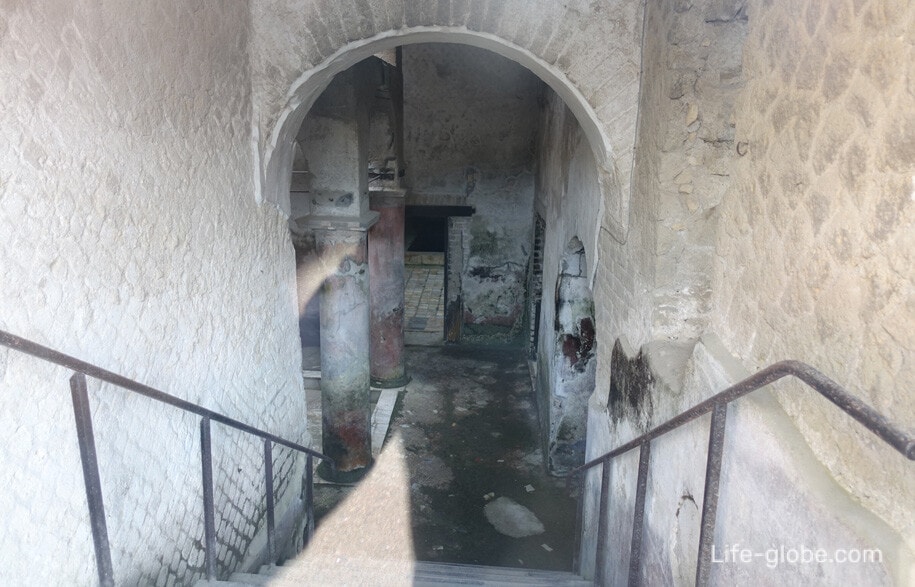
- sacred place (area Sacra), where the temple of Venus and temple dedicated to the four gods (Minerva, Vulcan, mercury and Neptune). Before the temple there are marble altars.
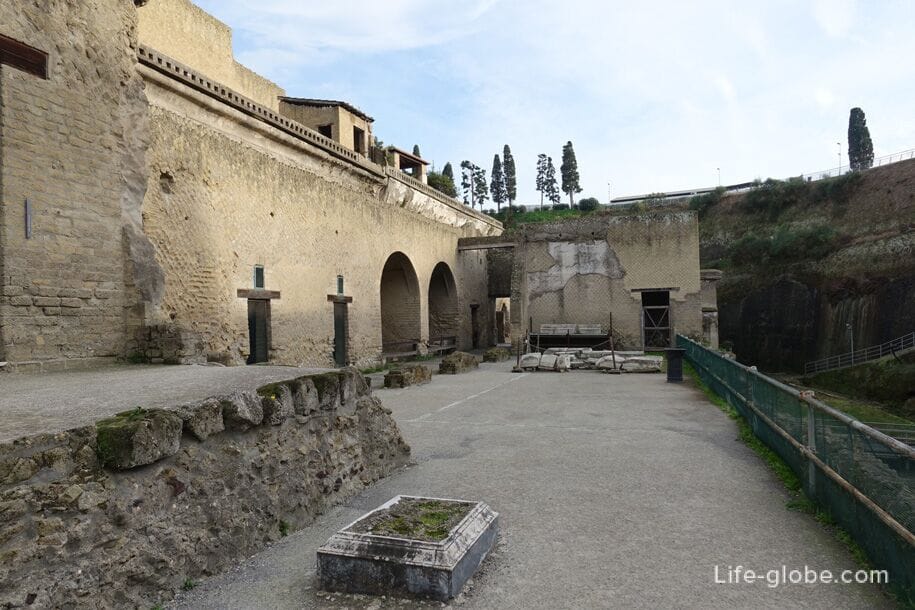
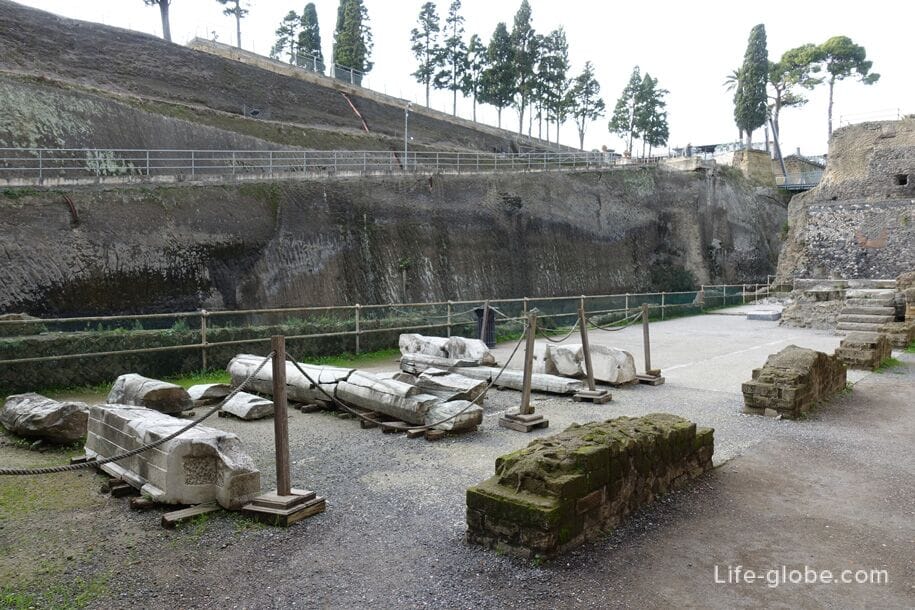
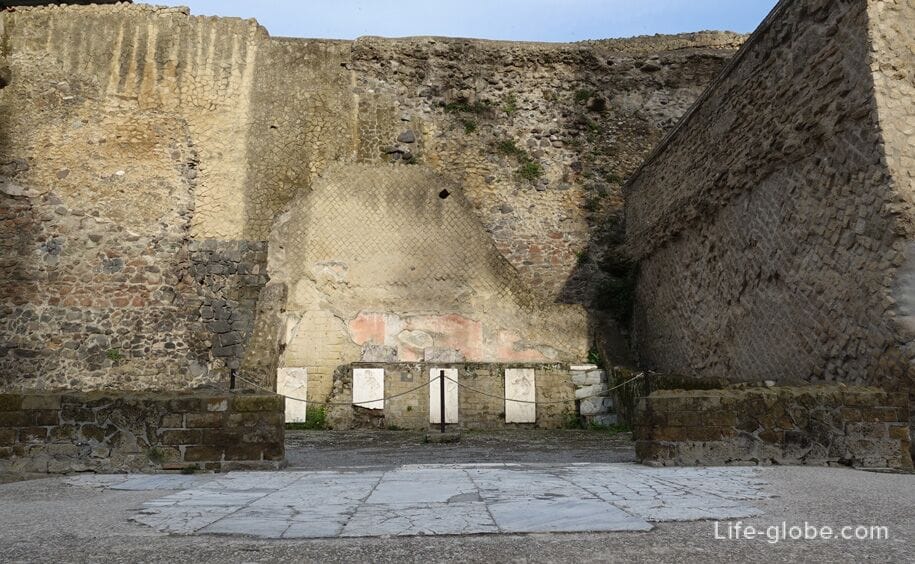
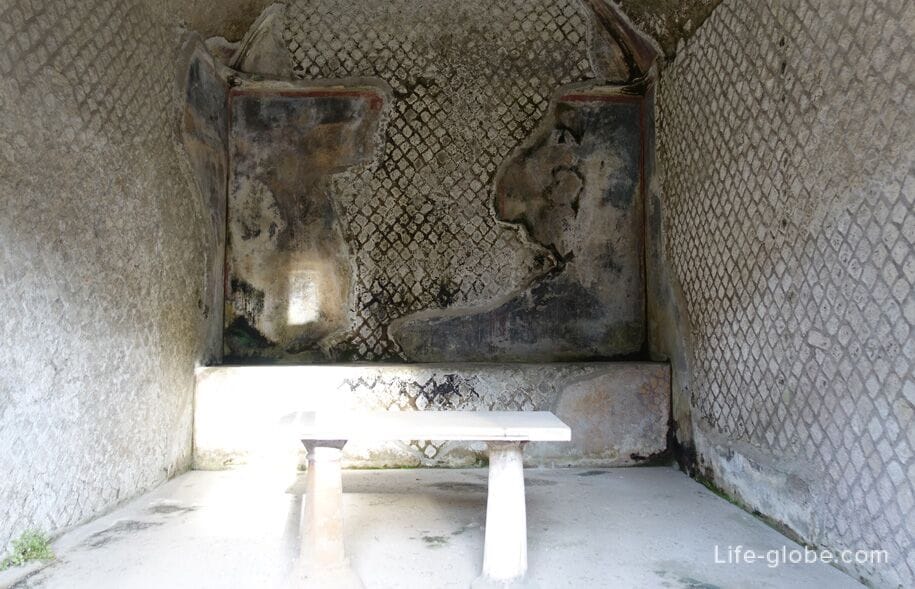
Bearings in terraced courts carved arches used for storage of boats. In these narrow openings, in the 1980-ies were discovered the skeletons of more than three hundred victims who had left their home the night of the volcanic eruption, fled to the sea in hopes help arrives. Their waiting was interrupted by a burning thread that is forever burned dreams and hopes of these people. They remained buried under a layer of volcanic rocks.
Especially touching was the discovery of the body of a young pregnant woman close to childbirth. From the body was extracted the remains of the unborn child about eight months. The body of another woman, richly adorned with earrings, rings and bracelets, was presented to the press as the body of the "Lady of the jewels".
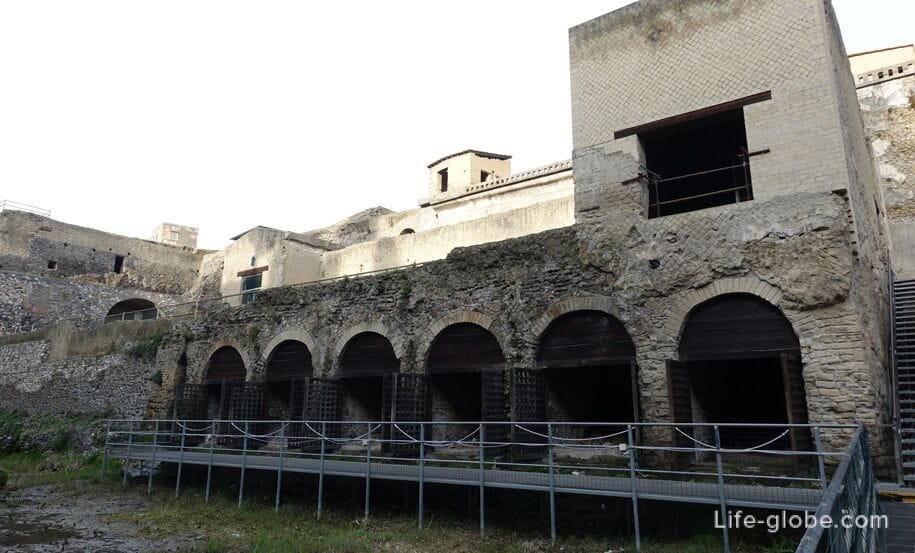
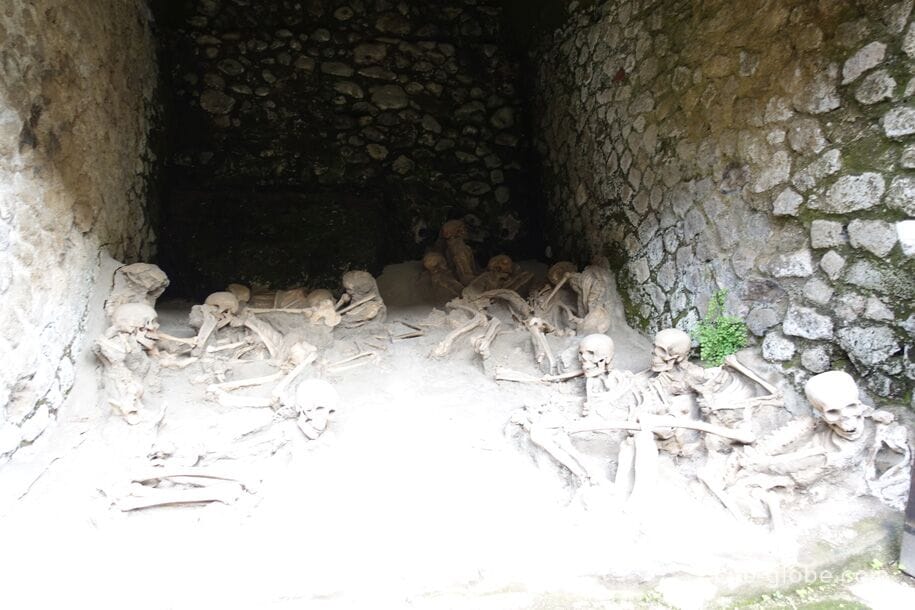


In the southern part of the archaeological Park, an enclosed pavilion, is one of the most important finds of charred boatdiscovered in the area of ancient beach on August 3, 1982, with three pairs of rowers and a helmsman. According to the most recent interpretations, it could be a military fleet under the command of Pliny the Elder, sailed from Messina to assist the city, which was threatened by the eruption. This inspires the hypothesis is confirmed by the fact that at a short distance from the boat was found the skeleton officer with a belt on which hung a scabbard with sword and dagger.
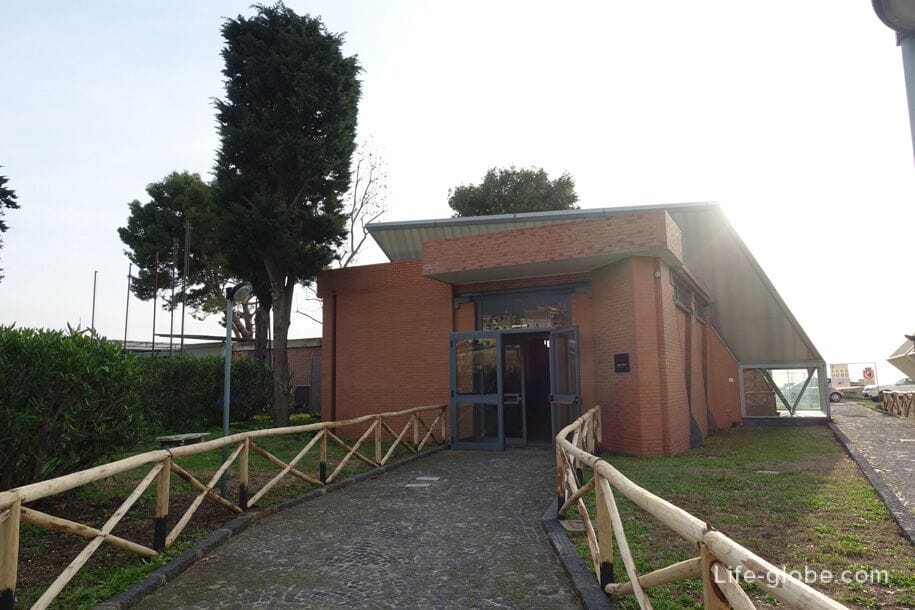
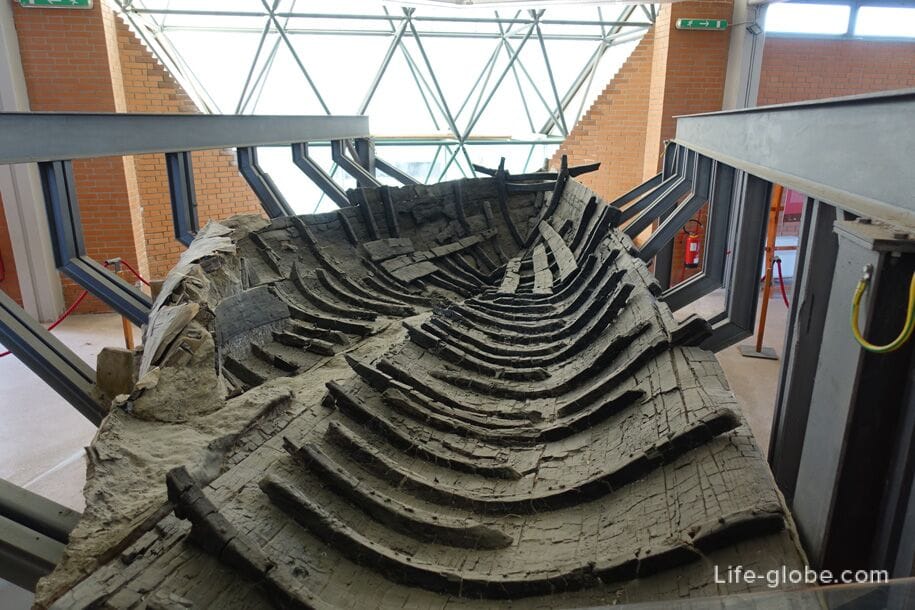
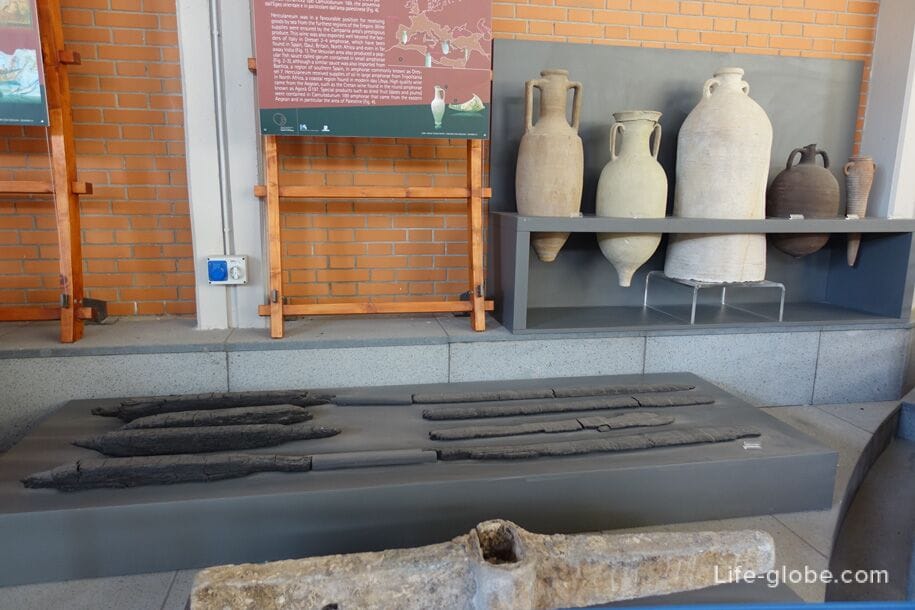

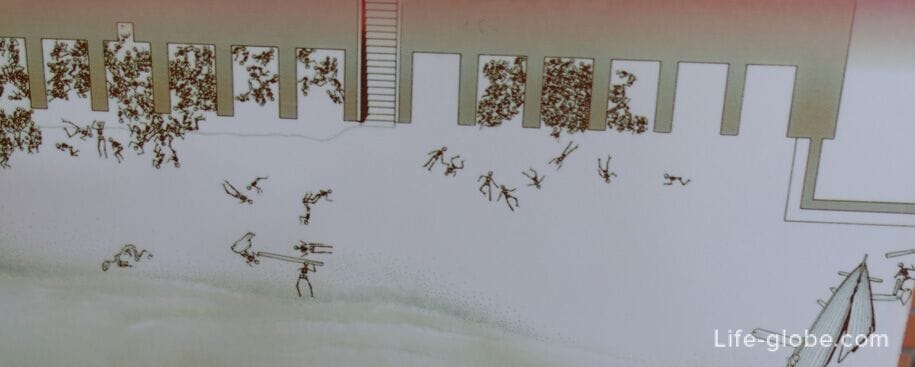
Also on the territory of the archaeological Park are: toilets, cafe, box office information point and kiosk where you can buy the audio guide.
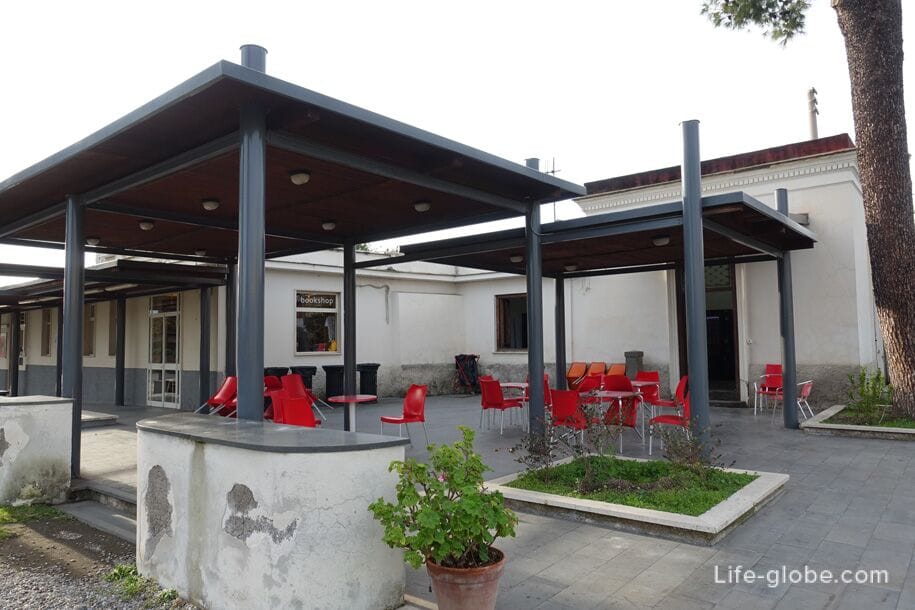
The territory of the main complex of the archaeological Park were found:
- theatre (Il teatro), located in the northwestern part of the city of Herculaneum, near the Piazza del Foro. It was built in the time of Augustus one of the most influential of the magistrates L. Annison Mammonism Rufus, and the project was entrusted to the architect P. Numisia. The building consisted of a half cycle longer than 50 m, vertically divided into three sectors, which could accommodate about 2,500 people. Very rich was the decoration of polychrome marble and statues used to decorate the stage and other monumental parts of the building. Many of them were discovered during the excavation of tunnels in the eighteenth century, and which today can be seen in the National archaeological Museum of Naples. Today this building is still buried under volcanic blanket and can be visited via a complex network of gallery cave;
- the Villa of the papyri (Villa of the Papyri) - the most famous of the luxurious villas at Herculaneum. Villa stretches to the sea on four terraces. Piso, a literate man who patronized poets and philosophers, built the Villa a fine library, the only one which has remained intact since ancient times;
- thermal complex (complesso termale);
- the house of the Dionysian reliefs (casa dei rilievi dionisiaci).
The archaeological Park of Herculaneum is located in Ercolano, at Corso Resina, Ercolano, NA 80056, Italy.
Opening hours for Herculaneum:
- from 16.03 to 14.10 from 8:30 to 19:30 (last entry at 18:00);
- from 15.10 to 15.03 from 8:30 to 17:00 (last entry at 15:30).
Days off: 1 January and 25 December.
Cost of tickets: full ticket to the Herculaneum archaeological park - 13 euros; entrance to the ancient theater of Herculaneum - 5.50 euros; entrance to the archaeological park + ancient theater - 15 euros. There are concessionary tickets; children under 18 - free of charge.
Free entrance, as well as in the archaeological complex of Pompeii, the - first Sunday of the month.
Tickets can be purchased at the box office on-site or in advance online. Site.
Attention! Opening hours, ticket price, weekends and free visits may vary, please check the information before travelling.
How to get from Naples
- by car, car hire...
- taxi to call a taxi here...
- electric trains, two railway stations:
1. Ercolano scavi Ercolano (Ercolano Scavi) is the closest to archaeological Park, the distance from the station to the Park is around 550 meters, walk along Via IV Novembre.
On this station there arrive trains of the company Ente Autonomo Volturno destinations such as Sorrento and Sarno. From Naples depart from the railway station Port Nolana (Porta Nolana), passing the Napoli Garibaldi station (Napoli Garibaldi). In the high tourist season at the Garibaldi station there are no free seats in the train. The ticket costs 2,20 Euros one way. Tickets can be purchased at the stations. Site.
2. Portici - Ercolano (Portici - Ercolano), which is located near the sea, in the nearby town of Portici, on the distance about 1.7 km from the Park of Herculaneum.
At this station arrive trains Trenitalia. From Naples leave from several railway stations: Napoli Campi Flegrei and Napoli Piazza Leopardi, Napoli Mergellina, Napoli Piazza Amedeo, Napoli Montesanto, Piazza Cavour (Piazza Cavour), Piazza Garibaldi Napoli (Napoli Piazza Garibaldi) is located under the station Centrale and Napoli Gianturco, Napoli S. Giovanni Barra. Ticket price 1,60 Euro. Tickets can be purchased at the ticket office and vending machines at the stations and also online. Site.
Maps are available free of charge at the offices of the Park of Herculaneum.
